 Eton Mess is in loving memory of a very gorgeous dog called India and is dedicated to her companion, my friend and enthusiastic reader Janet Watkinson.
Eton Mess is in loving memory of a very gorgeous dog called India and is dedicated to her companion, my friend and enthusiastic reader Janet Watkinson.
Welcome to my free short story for Halloween 2022. Those of you who have read my previous Halloween stories will know that they are generally traditional ghost stories, designed to cause a bit of a chill.
For some reason, I couldn’t come up with my usual ghost story this year. Maybe I just wore out my ideas last year, or maybe it’s because I really wanted something a bit more light hearted during these times of doom and gloom. Whatever the reason, I’ve written something different this year, though it’s very much based in the season.
When I was a child I used to adore school stories. Nothing could have been further from my East End schooling than the tennis and cricket matches of boarding schools but I loved them. The Chalet School were my favourites, closely followed by the Jennings books but I read every one of the genre I could get my hands on.
I even managed to wade through Tom Brown’s Schooldays. I adored George MacDonald Fraser’s follow-up books about the dastardly bully, Flashman, and his spectacular army career and there’s a good reason why the bully in this story is going into the cavalry. One of these days, if he’s made it this far through the war, I’d quite like to introduce him to Major-General van Daan who has a long memory and a really large dog.
My research into the customs of Eton College during this period made it clear that a lot of the traditions we associate with the school came in rather later. There doesn’t seem to be a great deal of uniformity about how the school, including the Boarding Houses, was run at this point, though it does seem to be clear that some of them were still being run solely by women. House masters did exist, but did not become fully established until slightly later in the nineteenth century. It suited my purpose for the young Van Daan to live under a more relaxed regime so I’ve placed him in Dame Lovelace’s Boarding House.
I hope you enjoy this latest adventure in Paul van Daan’s early life. I loved writing it and was surprised at the end to realise that, with one exception, Paul’s appalling language really hadn’t developed at this point. You could almost let your children read this one. It was definitely written for fun. Enjoy.
Eton Mess
Eton College, October 1795
Mr Julian Holland was correcting Latin grammar in the Masters’ common-room when the sounds of battle reached him. He tried to ignore it. Five years living in the midst of three hundred active boys had taught him the madness of intervening in every minor squabble. Often the combats proved to be nothing more than the kind of noisy play fight you might expect from a litter of growing puppies.
After a few minutes, Julian put down his pen and listened harder. The noise had grown louder and he decided that this was more than general high spirits. There was a savage chanting which suggested a fight of more than usual interest or even worse, a severe beating.
Julian stood up with a sigh, shaking out his gown. He occupied a relatively junior position among the teaching staff at Eton College and it was not really his job to maintain discipline among the boys, unless it was in his own classes. He was sure that the Headmaster or some of the Assistant Masters were within earshot, but he knew that none of them would make a move to find out what was going on unless somebody made a formal report. Mr Heath had only taken over as Headmaster the previous year and was so far showing every sign of continuing the indifference of his predecessor to the safety and welfare of the boys under his care.
Julian made his way at a gentle run down through the Long Walk. The noise seemed to be coming from the churchyard beyond the chapel which was further away than he had expected. Sound carried well on the chill autumn air and, as Julian rounded the end of the chapel, he could see them: a group of boys in a wide semi-circle close to the red brick wall and the old well on the far side of the churchyard. Their cheers and yells of encouragement drowned out any sound of his approach across the damp, leaf strewn grass between the gravestones.
As he drew close, Julian could see that his instinct had not betrayed him. Boxing was a popular sport at Eton and many parents paid extra for their sons to be taught properly, though many of the masters considered it a vulgar activity and preferred to encourage the young gentlemen to study the art of fencing. Some of the boys excelled at both.
Coming up to the edge of the group, Julian could see that the current match was uneven. Two boys were at the centre of the ring, one on the ground sporting a bloody face while the other was still on his feet, although he did not look in much better condition. Three older boys surrounded them, aiming kicks and blows where they could, with no consideration for the traditions of boxing or for any kind of gentlemanly conduct.
Julian knew all the boys under his tuition and was aware that these older boys were all approaching the end of their time at Eton. In the case of the Honourable Cecil Welby, who was eighteen and undoubtedly the ringleader in this systematic battering of younger boys, Julian could not wait for him to go. Welby was destined for a commission in a regiment of Hussars and Julian hoped passionately that the young officer would be ruthlessly bullied by his new messmates to give him a taste of his own medicine.
Welby and his friends had clearly not had it all their own way on this occasion. Ned Carrington’s nose was almost as bloody as his younger opponent’s and he was clearly distracted by his need to mop it occasionally on the sleeve of his coat. Barney Fletcher, the third combatant had what looked like the beginnings of a black eye and Welby himself sported a badly split lip. He was moving in on the younger boy now, his expression murderous.
“Carrington, Fletcher, get hold of his arms. Hold him still, he’s like a bloody gnat.”
As if to prove a point, the boy dodged back as the two converged on him, twisting sideways to avoid Fletcher’s grasping hands. Carrington managed to get a hold on his other side but let go with a yell as the boy turned into him and lifted a knee towards his groin. The blow missed however and the boy was off balance, giving Welby the opportunity to charge into him, knocking him flat.
All three of the older boys moved in, using their feet. Julian gave a shout of anger as all three connected with different parts of the boy’s body. He elbowed his way through the crowd which parted immediately. The atavistic roars of encouragement had died away. Partly Julian thought it was due to the arrival of a master but he also thought they had sensed the moment when an uneven mill turned into something savage and more dangerous.
“Welby, Carrington, Fletcher, get away from him,” Julian bellowed. “This is not the first time I’ve had to speak to you about bullying the younger boys, but you’ve gone too far this time. I’ll be speaking to the Headmaster and I also intend to write to your fathers personally.”
Welby did not speak but Carrington lifted his voice in immediate protest.
“That’s not fair, sir, he started it. We weren’t doing anything wrong. Just giving young Galloway a bit of a reminder of his duties. He’s Welby’s fag you know and he’s been altogether too choosy about what he will and won’t do. Nothing wrong with that, is there?”
Julian, who could remember the sheer misery of his own school days fagging for a bullying senior, wanted to point out that there was a lot wrong with it but he knew he would lose the argument. Fagging, the practice of a younger boy acting as servant to a senior boy in return for his protection was encouraged at most schools. In the hands of a kindly older boy it was harmless enough but in the hands of a bully like Welby it could be intolerable.
“He’s twelve,” Julian said coldly. “It shouldn’t take three of you to explain the rules.”
“It would have been all right if Van Daan hadn’t weighed in,” Welby said. “None of his damned business and I told him so. I hope he’s learned his lesson by it, sir. He needs reminding, the snotty little brat.”
Julian looked down at the leggy, fair-haired fourteen year old on the grass. He had uncurled himself cautiously and was beginning to sit up, wincing a little. Julian waited. He had no idea what was coming but he knew something was and he was poised to intervene. Van Daan rubbed blood from his face and felt around one eye which was beginning to swell. He looked up, giving Julian a glimpse of clear blue eyes, then shifted his gaze to Welby and gave a singularly charming smile.
“Every time you get close enough, Welby, I’m reminded of the smell of dog shit on a hot day. It’s the strangest thing; I always stop to check my shoe and then I realise it’s just you wandering past.”
Welby made an inarticulate sound and moved forward. Julian stepped in front of him, trying to look authoritative and Van Daan scrambled to his feet and stood ready to continue the fight. Julian looked over his shoulder.
“Van Daan, get Galloway up then get him over to the house and cleaned up. I will meet you in the Dame’s kitchen in one hour and if you open your mouth again, I’ll be reporting you. Get moving.”
The boy hesitated, then turned to where Galloway had dragged himself into a sitting position. The sight of the younger boy seemed to remind him of why he had become involved in the first place and he abandoned his fighting stance and went to help the other boy up.
“Come on Galloway, up you get. Dame Lovelace is going to have a fit when she sees the state of you. Make sure you tell her straight away that I didn’t do it or I’ll get my ears boxed on top of everything else.”
Julian watched them limp away. Galloway was leaning heavily on his companion although Julian was not sure which of the two was more seriously injured. He had seen Van Daan flinch as he moved, putting a hand to his ribs. He hoped that Mrs Lovelace, the Dame who ran the Boarding House to which both Van Daan and Galloway belonged, would be able to see through Van Daan’s bravado and get a doctor to have a look at him if necessary.
When the boys had disappeared through the gate Julian turned to look at Welby. The boy wore an expression of studied insolence.
“I don’t think the Headmaster will want to get involved, sir,” he said. “My uncle by marriage is on the Board, you know and none of them will want to interfere with me disciplining my fag. And Van Daan attacked me.”
Julian allowed his eyes to dwell on Welby’s battered face. “I can see he did,” he said. “If I were you, Welby, I wouldn’t want the rest of the school to know that the three of you were bested by a fourteen-year-old. All I can say it that it’s a good thing you didn’t get involved in a fencing bout with him.”
Welby’s face flushed scarlet and Julian gave a sympathetic smile. “Oh I’m sorry. I forgot that you did, last term. Lost half a year’s allowance betting on yourself, didn’t you?”
“If we all had the money he has to waste on fencing and boxing lessons, sir…”
“Enough. I’m not interested. I suggest for your sake that you keep this quiet. Leave Van Daan alone. You’ve only got a couple of months left here, Welby – you go at Christmas don’t you?”
“Yes, sir. To take up my commission.”
“Good. I won’t bother to write to your father, I’m well aware he doesn’t give a damn how you conduct yourself. But if I have to speak to you again about beating the younger boys, I’m going to write to your future commanding officer suggesting he keep an eye on you and explaining why. In the army you’ll be expected to behave like a gentleman. It won’t be a good start if your Colonel knows you’ve a history of not knowing how.”
Julian did not bother to say any more. He knew that Welby was perfectly right. Discipline at Eton was left largely in the hands of the older boys and unless something went badly wrong, it was unlikely that either the Headmaster or the Provost would intervene. He hoped that his threat might make Welby think twice before attempting to exact further revenge on either of the younger boys.
Julian went back to collect his marking then made his way along South Meadow Lane to the big house where Mrs Eleanor Lovelace presided over Whitchurch House, home to twenty boys ranging from the age of ten to eighteen. Julian’s own lodgings were in a narrow lane nearby and although it was not part of his formal duties to oversee the Whitchurch boys, he was on good terms with Dame Lovelace who frequently invited him to supper and often consulted him about the welfare of the boys under her care.
He found the Dame in the big square kitchen, tending to Tobias Galloway’s battered face. Washed clean of blood, it did not look too bad although there was a bruise on his temple and another darkening the fair skin of his jawline. The blood seemed to have come from a split lip. Julian came forward to inspect him and nodded.
“You’ll do, Galloway. You’ve done a good job, ma’am. All the same, I was wondering if you thought it might be an idea to write to Mrs Galloway to suggest that young Tobias goes home for a month or two for Christmas. It might do him some good.”
“He’s due to go home anyway, sir, his father has furlough from the army. I agree it might be wise to bring that forward a little, I’ll write to them this evening to suggest it. By the time he comes back after Christmas the problem should have solved itself.”
“You mean Welby will have gone.”
“Yes, and I won’t miss him. Horrible boy, he’s the worst senior I’ve ever had in the house.”
“Oh I don’t know, ma’am. Whitchurch House won’t be the same without the Honourable Cecil,” a voice said from the doorway. “He should be an asset if he gets to fight the French though. One look at that ugly face and they’ll run a mile. Thank you for intervening, Mr Holland. I know it’s not really your job.”
Julian turned to survey Paul van Daan. He had taken the time to clean himself up and change his muddy clothing but his face, as Julian had suspected, was more battered than Galloway’s. One eye was swollen and bruised, there was a nasty cut on his left cheek and another on his lip. A swelling lump and a gash on his temple made Julian wonder if that was where one of the kicks had connected.
“Look at the state of you,” Mrs Lovelace scolded. “Come and sit down and let me look at those cuts. You look like a low prize fighter. Your poor mother would turn in her grave if she could see you now, Master van Daan.”
“I don’t suppose she would, ma’am. She was used to me.”
Dame Lovelace shooed him into a wooden chair and went for a cold compress and some sticking plaster.
“Well you’ve lived under this roof for two years and I’m still not used to you,” she said. “You should know better, you know what a spiteful beast that boy is.”
“I know that once he starts hitting people he can’t stop,” Van Daan said, his eyes straying to Galloway’s white face. “It’s a pity he always has his friends with him. I wouldn’t bet on his chances if I could get him on his own for ten minutes.”
Julian watched as Dame Lovelace applied a plaster to the cut on the boy’s temple. “He’s four years older and a head taller, Van Daan,” he said gently. “This is not the first time this has happened. When are you going to learn not to get into fights with the seniors?”
“When the seniors stop picking on my friends.”
Julian opened his mouth to remonstrate and then closed it again. It was not the first time he had tried to have this conversation with Paul van Daan. Generally speaking, after the first few rounds with an older boy establishing his superior position in the school hierarchy, most younger boys either fell into line and waited for their own turn at the top, or persuaded their parents to continue their education at home. Van Daan, on the other hand, seemed to be making a single-handed attempt to change the entire system. It had not gone well for him today.
The Van Daan boy had not stood out when he arrived at Eton two years earlier. The gossip in the masters common-room was that he was the younger son of a wealthy Dutch businessman who had married into the English aristocracy. The boy’s mother and sister had died of smallpox and Julian remembered him on arrival as a tall slender twelve year old who looked faintly lost in the echoing halls of the old college.
The first weeks after Van Daan’s arrival had been marked with the usual scuffles and jockeying for position within his peer group, but Julian thought the boy settled well. He seemed well-liked by the other boys and tolerated by most of the masters. His father was wealthy enough to pay handsomely for his sports and social education and Van Daan quickly developed a reputation for being a talented boxer, a brilliant fencer and a good but unenthusiastic cricketer. He was also much in demand for football games where his height and fearlessness made him a favourite pick of the team captains.
His academic studies were less remarkable but Julian, who taught him Latin and geometry, quickly decided that it had nothing to do with his intelligence which was razor sharp. Van Daan’s studies were erratic. If something caught his interest he would devote hours of concentration to mastering it. He went through various enthusiasms for astronomy, Roman military history and learning to play the violin and he proved very able to stick to a subject. When he was bored however, he was an appallingly disruptive pupil with the ability to reduce a class to giggling inattention within minutes.
Julian, who enjoyed teaching and rather liked his pupils, found his ingenuity stretched to keep Van Daan busy and interested and thanked God he was not obliged to teach him Greek. The boy had been taught the basics at home by his previous tutor but showed no interest in taking it further and quickly declared silent war against Mr Archibald Thornton, the thin faced, irritable Greek master. Thornton was quick to lose his temper and enthusiastic in the use of the cane. By the end of his first year, Van Daan had developed a grim tolerance for physical punishment but never managed to look particularly repentant.
Dame Lovelace was pouring hot milk into a cup and adding a dash of brandy. “Off to bed with you, Master Galloway. We’ll see how you are in the morning, but I don’t think you should attend the classroom tomorrow. You look all in, you’ll be better for a good sleep.”
She shepherded the younger boy out of the kitchen. Julian sat down on the bench opposite Van Daan. “What happened?” he asked.
“I wish I knew, sir. Galloway made some kind of dust up about something Welby wanted him to do. I wasn’t there at the start, but when I came upon them, that arsehole and his tame monkeys were threatening to throw him down the old well. He was terrified.” Van Daan’s remarkable blue eyes met Julian’s gaze. “I’m sorry. I know I promised last time, but I couldn’t walk away.”
“I told you to come to me.”
“There wasn’t time, sir. What if they’d really done it? I couldn’t be sure.”
“And what if I’d not come along, Van Daan, and they’d thrown you down that well?”
“I suppose I’d be dead.
Julian sighed. “You can’t leave things alone, can you boy?”
“No, sir.”
“And you don’t know what set them off? It’s not like Galloway to argue with his seniors.”
“No, it’s got me in a puzzle as well. I’ll find out though. Or at least, I’ll get Will Cathcart to do it for me. Galloway will tell him.”
Julian could not help smiling. Cathcart had been an early victim of Welby’s bullying when he had arrived at the school. How Van Daan had managed to get the younger boy’s fagging duties switched to his own good natured senior, Julian had never found out but the two boys had been inseparable ever since. Cathcart was due to leave school very soon to take up a berth in the Royal Navy and Julian wondered if Van Daan’s sudden championship of Galloway had anything to do with him looking for a replacement. He rather hoped so. Galloway had struggled ever since his arrival and Van Daan’s bracing cheerfulness would do him a great deal of good.
Julian sighed. “All right. I’ll leave him to you, Van Daan. Come and speak to me if it’s anything I should know about. I’ve done my best to warn off Welby, so try not to antagonise him for a few weeks, will you? He’s not here for much longer.”
“And then he’ll be off to bully his men in the cavalry, I suppose.”
“That is not going to be your problem, Van Daan.”
The boy gave him a look which informed Julian that he disagreed. Julian lifted his brows and glared back. After a long moment, Van Daan said grudgingly:
“All right, sir.”
Julian considered asking for his word and decided against it. He got up.
“I have marking to finish, you exasperating young whelp. Try and keep out of trouble until class tomorrow, will you?”
“Yes, sir.”
“Perhaps it might be best if you take a day off as well…”
“No, sir. This isn’t bad. I’ll be there. Have you marked my work?”
Julian studied him. “Not yet. Why, will I need to borrow some of Dame Lovelace’s brandy first?”
“You might, sir. I think,” Van Daan said modestly, “that I did quite a good job of it.”
Julian could not prevent a laugh. “Eat your supper and get to bed early, Van Daan. You’re going to have the worst headache tomorrow.”
“It’s already started, sir.”
“Well listen to Dame Lovelace. She’s a good woman and she adores you. She’ll know what to do. Good night.”
***
There were two shared dormitories in Dame Lovelace’s boarding house plus three separate rooms for the senior boys. Two of them belonged to Cecil Welby and Ned Carrington, although neither appeared to have come home yet tonight. The other was occupied by Dominic Netherton, the third son of an Earl, an elegant youth rather incongruously destined for Cambridge and then the church and a family living in Hertfordshire. Paul van Daan shared nominal fagging duties for Netherton with his friend Cathcart. Netherton was a good natured and undemanding boy of eighteen whose only real requirement was money. He had discovered early on Paul’s talent for both fencing and boxing and had reaped a rich reward in organising competitions and running betting services on the outcome. In return he exercised a casual protection over the two younger boys and troubled them very little.
Paul had just finished his supper and was drinking brandy and milk under the eagle eye of Dame Lovelace when Netherton appeared in the doorway of the kitchen, casting a disapproving eye over the scene.
“I’ve just been hearing about your set-to with Welby, Van Daan.”
“Sorry, Netherton.”
“You’re a damned nuisance. He’s been complaining to me and saying you should be flogged.”
“It would be superfluous,” Paul said, indicating his battered face. Netherton studied him and sighed.
“All right. Keep out of his way until your match against Beeston on Thursday. I’ve got this month’s allowance on it: I can’t afford to lose. Are we clear?”
“Of course. I’ll be fine, it’s nothing serious.”
“Good. Is Galloway all right?”
“I think so. I’m going up to check on him now.” Paul hesitated. “Look, Netherton. I was wondering…you’re going to lose Cathcart next term, he’s off to the Navy. While you’re still here, maybe you could take over Galloway after Welby leaves? He’s a good lad and he’ll be grateful.”
Netherton glared at him. “Welby will want one of his friends to take him over.”
“You’ve no reason to worry about those two, they’re nothing without him. They won’t make a murmur.”
Netherton studied him for a while then sighed. “All right. I’ll speak to Galloway after Christmas. You’re such a pain in the backside, Van Daan.”
“I know I am. Sorry.”
“No you’re bloody not. Get up there and find out if he’s all right, poor little runt. If he’s worried, let me know and I’ll see if I can warn off Welby.”
“Thank you, Netherton. You’re a good sort.”
“I am a bloody pushover and you know it, you little bastard.”
Paul grinned and removed himself to the dormitory. There were eight beds but only five were occupied. Admissions to Eton had been low for several years, although they were currently slightly improved, possibly due to the change in Headmaster.
It was early for the boys to be in bed and Galloway was the only one tucked up in his narrow cot. On the bed next to him was the slim figure of William Cathcart, Paul’s closest friend at school. Cathcart was thirteen, almost a year younger than Paul and the eldest son of Lord Cathcart, a Scottish Peer. Cathcart had suffered at the hands of Welby and his cronies during his first term at school but had made a remarkably good recovery. He was due to leave in the summer to join the Royal Navy as a volunteer aboard HMS Melpomene with the Channel fleet and Paul knew he was going to miss him.
Paul closed the badly fitting door and joined Cathcart on his bunk. Galloway was sitting up, finishing the milk and brandy. He was very pale and looked completely exhausted. Paul studied him for a moment.
“Are you going to tell us what happened, Galloway?”
“I don’t much want to talk about it.”
“I understand that,” Cathcart said. “But we’re your friends, you know, we want to help. And it’s not like you to get into trouble with Welby. Normally you just…”
He stopped abruptly and Paul managed not to laugh. “Normally you’ve got more sense than me and just go with the tide,” he said tactfully.
“Normally I just do what he tells me to do.”
“Well, yes,” Cathcart said. “And it’s the intelligent thing to do, we all know it.” He shot a glance at Paul. “Well, most of us do. What went wrong this time?”
“I can’t tell you.”
“It can’t be that bad.” Cathcart frowned suddenly. “Or at least, I suppose it could be, but I didn’t think Welby was like that. I mean I’ve never heard…”
He broke off, studying the younger boy with concern. Galloway flushed scarlet as he appeared to catch his meaning and shook his head, setting down the cup on the wooden floor.
“No! Nothing like that.”
“Are you sure?” Paul said. He had heard vague stories of one or two of the older boys requiring more than domestic services from their fags, although as far as he knew it had not happened during his time at the school. Gossip travelled quickly at Eton and Paul thought he would have known if Cecil Welby had abused any of the younger boys in that particular way.
“No, I swear it. Just the usual stuff, running errands, cleaning his room and suchlike. He’s beastly and he’ll give his boys a box around the ear if we’re not quick enough, but nothing worse until today.”
“So what did he want from you today, Galloway? Is he after money? He spent a couple of months trying to extort what he could from me once he realised my brother sends me a guinea under the seal of every letter. Come on, spill it. We can’t help you if we don’t understand.”
“It’s a secret.”
“We won’t tell,” Cathcart promised. “I’ll give you my oath.”
Galloway was silent for a moment and Paul could see that he was torn between wanting to share and his ability to trust.
“I promise, Toby,” he said gently. “What does that bastard want?”
Galloway took a deep breath. “He wants my dog,” he said.
***
The bitch was part-spaniel, five months old and very playful. She was housed in the stable attached to the George Inn under the care of a skinny stable-hand who was being paid to look after her.
Paul sat in a pile of straw with the puppy on his lap licking his face while Galloway told the story. He had heard about the puppies from one of the grooms in the college stables and had been longing for a dog since losing his elderly hound the previous year. Unusually wealthy due to a generous birthday gift from his uncle, he had bought her and found a temporary foster home in one of the staff cottages with a gardener.
“It’s only until Christmas. My father is coming to collect me to take me home. He’s on furlough for three months before going off to India and he wants to spend the time with me. He and my mother have already agreed to me getting another dog, so he’ll be happy to take her. I thought it was an excellent idea all round. I’ve been spending all my free time with her, training her.”
“What’s her name?” Paul asked. The puppy was lying on her back as he scratched her tummy and he was already in love. His mother had adored both dogs and horses and in the horrible weeks after her death Paul could remember going to sleep each night with her favourite spaniel curled up in his arms for comfort. The memory hurt but also made him smile.
“India. I called her that because I’d just heard about Papa’s posting. It was all going so well until Welby found out. He told me I wasn’t allowed a dog in college and that if I didn’t give her to him, he’d tell the Headmaster and she’d be taken away. When I told him to get lost, he threatened to drown her. He’d found out that old Jones was looking after her for me and I knew if he went after the poor old fellow he’d have to hand her over.”
“Where did you come up with this place?”
“My parents always put up at the George if they come up to visit for any reason. I’ve known some of the lads here for years. It’s expensive, it’s costing me every penny of my allowance, but it’s only for another few weeks. As long as I can keep her hidden from Welby, we’ll be fine. But he worked out that I’d moved her and was trying to get me to tell him where. I didn’t tell him.”
Paul was twisting some straw into a makeshift ball. He tossed it across the stall and laughed as the puppy bounded after it. “She’s gorgeous. I can’t believe you didn’t tell us about her, Galloway, you little idiot. Far easier to look after her with three of us and if you run out of money I can help.”
Galloway gave a slightly tremulous smile. “I should have told you. I can’t take your money though, Van Daan.”
“Yes, you can. I’ve nothing useful to spend it on and I’ll take puppy cuddles in payment. I miss the dogs at home. My mother used to have a spaniel who looked rather like this. India, come here. You’re supposed to fetch the ball not eat it, you’ll be sick.”
“Are you sure Welby doesn’t know about this place?” Cathcart asked.
“As sure as I can be, but I’m terrified he’ll find out.”
“We need to get rid of Welby,” Paul said, stroking the spaniel’s ears. “He’s going anyway at Christmas, if we could just find a way to get him sent down sooner you’d have nothing to worry about. I can’t believe he’s not managed to get himself expelled before now.”
Galloway snorted. “The Headmaster doesn’t see thrashing the junior boys as a problem.”
“No. What would he see as a problem?”
“Theft? Murder? Seducing the Provost’s daughter?” Cathcart said.
“I’m not sure we can set him up for any of those,” Paul said regretfully. “Not without causing serious harm to somebody else.”
“I was joking, Van Daan.”
“So was I. At least…I think I was.” Paul stopped stroking India’s silky ears. He was staring into the distance as an idea began to form in his brain. After a moment the puppy grew bored and began to nibble at his jacket. Paul took no notice. The idea was taking shape, forming into something like a plan. It was possible. It could work. It could…
Paul caught sight of the faces of his two friends. They wore identical expressions of sheer horror and he laughed aloud.
“Your faces.”
“No,” Cathcart said firmly. “Whatever you’re thinking, stop thinking it. I’ve come to know that expression. I have approximately six months left at this school and I’ve no wish to be kicked out before then because I followed you in some mad scheme to get back at Welby.”
“You’re going to love it.”
“I’m going to hate it.”
“You’re not. It’s not illegal and it won’t hurt anybody. At the very least he’ll end up looking like a complete idiot and if we’re really lucky they’ll send him down early for being out after curfew and for causing a dust-up with the townspeople. Don’t be such a boring toad, Cathcart. Don’t you trust me?”
“No.”
Paul looked at Galloway. “I don’t trust you either, Van Daan,” the younger boy said earnestly. “But…will it keep him away from India?”
“He is going to be far too busy to even think about India. Though if he does come anywhere near her, I’m going to drown the ugly bastard in the Thames, I promise you.”
Galloway gave a broad smile. “I think you would, too.”
“I definitely would. But I’m not going to need to. What’s the date?”
“The date?” Galloway looked baffled. “It’s the twenty-sixth of October.”
“Exactly,” Paul said rather smugly. “Which gives us five days to plan this.”
Cathcart gave a puzzled frown. “You’re not thinking of doing something on Mischief Night are you? The Head said only the other day that he’d expel any boy caught playing tricks on the townies this year. I don’t think even Welby would be stupid enough.”
Paul shook his head regretfully. “No, we’d never get away with it. After Grantham set fire to that barn last year and nearly burned down Selby Street they’re going to have us firmly locked up on the thirtieth. I’m thinking of All Hallows Eve.”
Both his friends stared at him blankly. Eventually, Cathcart said:
“What in God’s name is going to happen to Welby on All Hallows Eve, Van Daan? Apart from a ducking if he’s bobbing for apples, that is?”
Paul gave a broad smile. “We’re going to persuade him to go ghost hunting,” he said happily.
***
The telling of ghost stories was a time-honoured tradition at Eton and Julian rather imagined at most other boys’ schools. He remembered from his own time, both at Eton and Cambridge, cold winter evenings toasting bread by the fireside and competing to tell the most ghoulish tales.
There were currently fourteen boys in residence at Dame Lovelace’s boarding house and all but the two youngest were scattered around the boys’ parlour when Julian arrived to supervise the residents during Mischief Night. The practice of playing tricks and pranks on the neighbourhood on the evening of the thirtieth of October varied greatly around the country and Julian had never heard of it in his own county of Surrey, but he had discovered it was very well established in the town of Windsor.
Until recently the Headmaster had mostly ignored the escapades of some of the wilder elements in College. They tended to consist of racing through the darkened streets banging on doors or taking buckets of dung from the stable heap to leave on the doorsteps of unwary citizens. It was exasperating but harmless and the town boys were just as enthusiastic as the College boys.
Over the past few years however, the pranks had been escalating. Competition between the town youths and the boys from College had raised the stakes to the point where the pranks were becoming either expensive or dangerous. One year some of the Thames boatmen were furious to discover most of their barges had been sunk during the night, while a farmer on the outskirts of the town had lost two cows to drowning when every gate on his farm had been opened. There were angry local meetings where the townspeople blamed the college and the College pointed to the town.
On the previous year, the most imaginative prank and Julian’s personal favourite, was when Mr Calverley, a local solicitor who had been particularly vocal on the subject of the College boys and had even gone so far as to take his walking cane to two of the juniors he suspected of stealing eggs from his poultry yard, arose to find his hen house completely enmeshed in a cage of string. Julian had been tasked with enquiring into the matter and he had been baffled at how difficult it was to release the squawking hens until he realised that once the string was in place it had been thickly painted with glue, which had set very well during the cold night. It took the lawyer and his servant almost an hour to chip and cut the string away and when the indignant hens sallied forth, every one of them was painted a bright shade of green.
Green hens were outrageous but more or less harmless, however somebody had gone further and set fire to a partly derelict barn at the end of Selby Street. The fire had looked likely to spread and though the residents had managed to put it out, helped by a fortuitous shower of rain, two College boys had apparently been seen in the vicinity and the Headmaster declared that Mischief Night was over for the scholars of Eton College. Orders had been given and threats made, but on the night itself, the Headmaster allocated each one of the Assistant Masters to a Boarding House where they were to check if any of the students were missing and keep an eye out for anybody trying to abscond.
Julian had been ready for a sulky response from the three senior boys who were used to a good deal of freedom in their spare time. To his surprise he found Netherton, Welby and Carrington happily consuming buttered toast and hot chocolate with their juniors while the Honourable Martin Wynne-Jones told a gruesome tale about a headless horseman. Julian bowed politely to Dame Lovelace, who was settled in an armchair with some knitting, and took a chair in the corner.
There was silence as Wynne-Jones finished his story. After a moment, Paul van Daan gave an exaggerated shudder.
“That was excellent, Jonesy. It’s a good thing I can’t imagine your horseman making it up those stairs or I’d struggle to sleep tonight.”
“Your turn, Van Daan,” Netherton said lazily. “Don’t you have any grisly tales for us?”
“I’m sure there’s one my brother told me about a ghostly hunt, but I can’t for the life of me remember it,” Van Daan said regretfully. “It’s a shame because he scared the life out of me for a month afterwards, I used to lie awake listening for the phantom hunting horn. My mother was furious with him. What about you, Welby? Anything from Dorset?”
It was said casually but Julian thought he recognised an olive branch and was surprised and a little touched. He half expected Welby to reject it scornfully but the older boy could not resist the opportunity to take the stage. His story involved a ghostly sea captain and was not as well told as Wynne-Jones’ but the boys seemed to enjoy it and it rather pleased Julian to see what appeared to be a cautious truce.
He looked again at Van Daan who was sprawled on a shabby rag rug on the floor and wondered if the boy was yet aware of what a gift he had for leadership. The casual charm seemed effortless even at fourteen and Julian hoped he would find the right outlet for his undoubted talents as he grew older. He had told Julian that his father wanted him to go into the law but Julian could not imagine that restless energy confined behind a desk and certainly did not see Paul van Daan as a clergyman. The army and the navy were both traditional careers for a younger son and might well suit him better.
Several more stories were told and Julian, called upon to contribute, told them about the ghost of Anne Boleyn who was supposed to haunt the Tower of London. He could see that the younger boys were getting sleepy. Dame Lovelace had observed it too and was folding her knitting in preparation to sending them up to bed. Paul van Daan looked over at her and gave her a winning smile.
“One more, ma’am. We’ve been on a ghostly tour around Britain tonight, but we’ve had nothing local. Aren’t there any gruesome tales about the College? Or even the town? You must know, surely.”
The Dame sniffed. “I’ve better things to do than listen to ghost stories, Master van Daan. Not that my father didn’t tell me about some strange noises in the college library when he was caretaker here forty years ago, but he told me he never actually saw anything…”
“What did he hear, ma’am?”
Dame Lovelace settled herself back in her chair and Julian watched, hiding a smile. At this rate it would be midnight before the boys were in bed but he was enjoying the unusually mellow atmosphere. Dame Lovelace told a surprisingly effective story of her father.
“That gave me the chills,” Cathcart said appreciatively when she had finished. “It’s almost worse imagining what he might have seen than actually seeing the ghost. Reminds me of that story about the boathouse.”
“What story?” Van Daan asked.
“You know, the one the boatman told us when we took shelter there from the rain. At least…weren’t you there, Van Daan? Maybe it was just me and Galloway.”
“I don’t remember it,” Van Daan said, sitting up from his prone position. “Tell us immediately. And after that, I’m going to bed. It’s been a good Mischief Night and the town can sleep safely, though I’m not sure I will after this. What’s the story of the boathouse?”
“Apparently it’s haunted. Old Peterson reckons he’s seen her.”
“Seen who?” Netherton said, intrigued. The sleepy boys seemed to have woken up at the mention of the boathouse, which was regularly used by the College boys. “Tell us about it, Cathcart. That’s very close to home; I’m in and out of there all the time. I can’t believe you’ve left this to the very end.”
“And that will have to be the end,” Dame Lovelace said firmly. “You’ll all be sleeping through lessons tomorrow.”
“It was this time of year, according to Peterson,” Cathcart said. “She was quite young, the daughter of some local tradesman and she got involved with someone at the College. Peterson couldn’t say if it was a senior boy or a master…”
“This does not sound like a suitable story for young ears,” Dame Lovelace said in repressive tones.
“No, no ma’am, of course. Like I say, I don’t know the details but whatever happened it went wrong for her. I daresay he dropped her or left College or some such thing but she couldn’t get over it. People used to see her wandering along the river bank where they used to meet, crying. One day she didn’t come home at all and it was pouring with rain. Her father went out to look for her but there was no sign along the river pathway. He was beginning to worry she’d missed her footing and slipped into the river so he made his way to the boathouse to see if any of the boat men were there and had seen her. The place was in darkness but the door was unlocked, so he pushed it open and saw her there. She was hanging from the rafters, swaying gently.”
“That’s an appalling story,” Julian said, watching the faces of some of the younger boys. “And quite enough for tonight.”
“It’s not a ghost story though,” Van Daan argued. “Or is it, Cathcart?”
“According to Peterson she’s still seen along that path just as dusk is falling. People have heard her crying as well – inside the boathouse, though when they open the door there’s nothing there. Although one night – perhaps it was the anniversary, we don’t know – one of the boat men saw her in the shed: just her outline hanging there.”
“Oh that is definitely enough,” Van Daan said, getting up. “If anybody in our dorm wakes up yelling in the night, Cathcart, it’s your fault. And it might well be me. I’m off to bed. Goodnight, ma’am. Thank you for a very good Mischief Night, I think I enjoyed it more than last year. And you too, Mr Holland. You can report back that we were all present and correct and behaved ourselves very well. We’ll be staying home tomorrow as well, I swear it. After that little performance, I’d happily stake two guineas that even Netherton and Welby wouldn’t have the nerve to be wandering along the river on All Hallows Eve. Goodnight all.”
Julian watched him go, followed by his friends, their feet clattering on the bare wooden stairs. He agreed that the evening had been a success and that the boys appeared to have behaved impeccably, so he could not understand why he had the wholly irrational feeling that Paul van Daan had in fact just behaved very badly indeed.
***
Paul fell asleep quickly and was awoken by Cathcart bouncing on the end of his bed. He managed to stifle a squawk, sat up and smacked his friend across the ear.
“What was that for?” the younger boy whispered indignantly.
“For scaring the shit out of me in the middle of the night after three hours of ghost stories,” Paul hissed. “Outside before we wake up the whole house.”
Cathcart followed him onto the dark landing. It was very cold and Paul shivered.
“Make it quick, my teeth are chattering. Did he bite?”
“He bit,” Cathcart said with great satisfaction. “The bet stands at two guineas that he’ll parade along the river path alone at dusk on All Hallows Eve, then stay in the boatshed until midnight. Carrington volunteered to stand as guarantor that he goes through with it but I pointed out that he wouldn’t be alone then so the bet wouldn’t hold good. I’ve told him you’re giving a shilling to Peterson to watch from that cottage of his to make sure he doesn’t try to sneak out of there.”
“Very good idea. Am I in fact giving a shilling to Peterson?”
“Yes. Which he’ll be spending at the King’s Head, happily not looking in the direction of the boat shed.”
“Better and better. I’ll get down there directly after my Greek class to set everything up. I hope I can manage to stay awake through the deathly boredom of old Thornton droning on. He’s not caned me for months, he must be getting a bit twitchy by now. Come on, let’s get back to bed before the Dame catches us. Or before we freeze to death and start haunting the place ourselves.”
Despite his disturbed night, Paul managed to get through both Greek and Latin without incident the following day and was even faintly smug when Mr Holland praised his recent translation. He regretfully turned down an invitation to play football during the afternoon and slipped away about his own affairs, although he made sure that he was back in plenty of time for dinner and joined in with the conversation about the football match as though he had been present.
Welby was quiet during dinner and Paul wondered if he was regretting his rash acceptance of the bet. When the table was cleared, the boys collected their books for the study period and for an hour and a half the big schoolroom at the back of the house was silent, broken only by the rustling of paper, the scratching of pens and an occasional deep sigh.
Dame Lovelace rang the bell which signalled the end of formal study and the boys broke up into informal groupings. In some Houses there was still a great deal of supervision during the evening but Dame Lovelace was known to be lenient, particularly with the older boys. It was not uncommon for the seniors to slip out to meet friends from other Houses in one of the local taverns and providing they returned by eleven o’clock and did not wake the house up because they were drunk, she would turn a blind eye.
During the summer months she would also allow some of the older juniors to go down to the river to swim or to row, or to the field to play games. Tonight it was already growing dark and Paul was pleased to see that Welby had vanished, although Netherton was still there, setting out a draughts board. Paul joined him.
“Netherton, can you cover for me? I want to go up to the hall to practice for an hour, I’ve got two fights next week and I’m feeling sluggish after my skirmish with Welby. I need to get myself moving again.”
Netherton shot him a glance. “Do so,” he said firmly. “I thought Beeston had you beaten, I’ve never seen you so slow. Welby has gone off somewhere, something to do with a wager. I hope he bloody loses, whatever it is. I’ll tell the Dame I sent you on an errand. Take a lantern though, it’ll be pitch black coming over the field in the dark and I don’t want you spraining your ankle. I’ve got a huge bet on you against Wolverton and there’s a big take up on the betting book as well. I need you to win.”
Paul grinned. “I can beat Wolverton with one hand,” he said. “Thank you. I won’t be more than an hour or so.”
“She won’t check the dorms, she never does. If you’re late back I’ll tell her you’ve gone to bed and I’ll make sure the side door is unlocked. See you later.”
Paul collected a closed lantern from the kitchen and slipped out through the side door. He was halfway across the field when he heard footsteps and stopped, waiting.
“Van Daan, is that you?”
“Yes. What the bloody hell are you doing here, Cathcart? If we get caught it will be six of the best at the very least. And you should never have brought Galloway. It’s all right for me…”
“Shut up and get moving or we’ll miss the fun. I’m reliably informed by Carrington that Welby went first to the Queen’s Head for refreshment. If we cut across by Peterson’s Cottage we should get there in plenty of time. I had a look earlier and there’s a place behind those three oaks which gives an excellent view of the boathouse door.”
Paul held up the lantern and began to walk faster. “I wish I could see his face when he opens that door,” he said wistfully. “But watching him run will be a lot of fun. I was trying to think of a way of getting him into trouble for being out after hours, but it won’t wash. Firstly because we’re all out as well. But also, it will come home to Dame Lovelace and she’s a good sort. I’d hate for her to lose her post because she doesn’t sit on us all the time. Still, it will scare the life out of Welby and as long as we see him run, Peterson is happy to confirm that he did too.”
“And how much did that cost you?” Cathcart said cynically. Paul laughed.
“Whatever it cost me, it was worth it. Did you hear back from your father, Galloway?”
“Yes, I got a letter this morning. He’s coming down to collect me himself; he’s probably on the road by now. And he’s very pleased about India. I knew he would be.”
“Lucky little bastard. I wish I was going home early for Christmas,” Paul said dispassionately. “Or maybe I don’t. My father is never especially pleased to see me. I miss Joshua though, and my dogs and horses. And Carl.”
“The parson’s son?”
“Yes. We’ve been friends since…oh forever. I wish you could meet him, you’d like him. Look, it’s grown misty over the river. Gives a nice atmosphere. This way, we can cut through the trees.”
They were barely in position when Paul heard footsteps approaching along the footpath. They seemed erratic and at first Paul did not think it was Welby at all, but as a lantern similar to the one he had recently doused came into wavering view through the swirling mist, he could see the older boy’s face. Welby looked satisfyingly nervous, glancing around frequently as though expecting to see a ghostly form emerging from the mist.
The weather was a bonus for Paul’s plan, since it virtually guaranteed that nobody else would be taking a night time stroll along the river. He watched Welby approach the big wooden structure of the boathouse and wondered suddenly if he was slightly drunk.
At the door, Welby hesitated, lifting his lantern. Paul hoped that Peterson had followed instructions and left the shed unlocked. Welby looked around him again and Paul could almost see him wondering if he could get away with sneaking off after his evening walk and not spending the next few hours in the dark boathouse. Paul could have reassured him that he was not likely to be there for long.
After several minutes, Welby stepped forward and took hold of the latch. Paul could see his figure outlined against the mist. The wooden door creaked slightly as Welby opened it cautiously, adding to the atmosphere. Paul realised he was holding his breath.
Welby screamed.
It was a high-pitched sound of sheer terror and it told Paul all he wanted to know about how well his plan had worked. Welby must have bolstered his failing courage in the tavern but the drink would only have made the shock worse. There was a scrabbling and a clatter and then the light from the lantern was abruptly extinguished, presumably because Welby had dropped it.
Paul waited, listening. He could hear the older boy crashing about down at the path, sobbing in terror. Remembering how frightened Galloway had been the previous week when Paul came across him close to the old well, Paul felt a sense of savage satisfaction. He hoped that Welby remembered this the next time he bullied a terrified boy six years his junior. He also hoped that Welby sprained his ankle racing back up to Dame Lovelace’s House.
There was another scream, then a yell of terror and then an enormous splash. After that, there was only splashing, with an occasional cry. Paul listened for a moment.
“He’s gone into the river,” Galloway said.
Paul waited. The next cry was more of a gurgle. “Of course he’s gone into the river,” he said. “He’s a bloody idiot.”
The three boys remained frozen between the oak trees. The noise continued for a while. Eventually a terrified wail floated up from the darkness.
“Help! Somebody help me!”
“He can’t swim.” Cathcart said.
Paul listened for another moment and realised that his friend was right. The enormity of how badly their plan had gone wrong made him furious.
“Of course he can’t bloody swim!” he roared. “You would just know it. Of all the useless good for nothing dog turds I’ve been unfortunate enough to meet in my short life, the Honourable Cecil Welby is top of the list. His inability to swim is…oh never mind. Galloway, take my tinder box. See if you can get the lantern lit again. Come on, Cathcart, we need to get him out of there.”
He was halfway across the grass towards the river when he heard his friend’s voice. Cathcart sounded apologetic.
“I’m afraid I can’t swim either.”
Paul froze. He realised he had no time to say any of the things he wanted to say and probably did not know enough swear words to express his feelings anyway. He said the first thing that came into his head.
“Oh for God’s sake! You’re about to join the bloody Navy!”
The river was high because of recent rain and freezing cold. Paul stripped off coat and boots and waded in, following the faint sounds of Welby’s voice. It sounded as though the older boy had managed to keep himself afloat but was clearly struggling. Paul struck out strongly in the direction of the sounds and reached Welby just as he went under again.
For several long minutes he struggled with the older boy in the water. Welby was beyond terror and in his panic he fought rescue. He was bigger and stronger than Paul and for a while it felt as though the only course would be to let him go under. Paul hung on grimly, trying to dodge his flailing arms. Eventually sheer exhaustion slowed down Welby’s frantic struggles and he allowed Paul to grasp him around his chest and tow him to the river bank.
Cathcart and Galloway were there with the lantern lit and Paul staggered out and sat down suddenly on the bank. Only now, with Welby safe and vomiting river water onto the grass, did he realise how exhausted he was. He lay back, letting his friends fuss around him and wondered how close he had come to dying in the cold waters of the Thames.
***
It was drizzling steadily over the courtyards and college buildings. Julian had deliberately found reasons to be present as the Headmaster and Mr Thornton presided over the inquiry into the events of All Hallows Eve. As the informal Housemaster of Whitchurch House he felt justified in pushing his way into the process.
Welby had recovered from his near drowning but was curiously subdued through the questioning. He told the story of the bet and his subsequent terror but seemed too embarrassed to dwell on how badly he had been frightened by a white muslin gown hung by ropes from the beams of the boat house. It had been decided, given his unauthorised absence from his Boarding House and the evidence that he had been drinking that evening, that he would leave College immediately and spend the remaining months before he took up his commission at home.
Paul van Daan was alarmingly composed as he related the story of his practical joke on Welby and how he had managed it without assistance. Julian was deeply appreciative of how well he was able to explain every aspect of the plan, even to the fact that he had been given the idea by Cathcart’s innocent retelling of a local ghost story. Julian knew it could not possibly work, since both Galloway and Cathcart had been caught out of their rooms after hours, but he approved of Van Daan’s efforts to excuse his friends.
The Headmaster was quietly furious. Mr Thornton, Julian thought, was slightly triumphant. Sentence was passed for the following morning before the entire school. Julian thought the matter was finished, but it seemed that Van Daan had more to say. As the Headmaster gathered his gown about him, the boy said clearly:
“Headmaster, I’m sorry. You’re right, I deserve the caning. But not these two. Cathcart came out to find out what I was doing and Galloway followed him. Neither of them knew. This isn’t fair.”
The Headmaster paused. “They were both outside beyond curfew, boy. That in itself…”
“Maybe. Two or three strokes. But not ten, that’s too much. This was my fault. I was angry with Welby and I planned the whole thing. They’d nothing to do with it.”
The Headmaster hesitated and Julian held his breath. He wondered if Van Daan might have reached him. Before he could speak however, Thornton cleared his throat loudly.
“Utter nonsense. Cathcart made up the story which led to this whole thing, there was a room full of witnesses. As for the Galloway boy, he is guilty of keeping a dog without permission, Headmaster. I have instructed my senior boys to make enquiries about where the animal is being kept and to arrange for it to be destroyed.”
Van Daan swung around and the expression on his face unexpectedly broke Julian’s heart. He rose and stepped forward.
“I was present on Mischief Night when the boys told their ghost stories, Headmaster, and for what it is worth, I think Van Daan may be telling the truth about the fact that they knew nothing of his plan. Cathcart heard the story from some local boatman and I think that gave Van Daan the idea. With regard to the dog…”
“It is utterly forbidden to keep an animal on school premises,” Thornton said sternly.
“The dog is not being kept on school premises, Headmaster, and I have made my own enquiries,” Julian said easily. “It appears that the animal actually belongs to Colonel Sir Edward Galloway who will be arriving within a day or two to collect it, along with his son. I would not personally wish to explain to him when he arrives that you have beaten his son and had his dog destroyed. It is, of course, up to you.”
There was a long, difficult silence. Eventually the Headmaster said:
“I have no interest in the Colonel’s dog of course. However, his son has clearly broken school rules and endangered another student. The punishment will stand.”
The procedure for corporal punishment at Eton was agonising to watch. Julian had only once been flogged during his time at school and had mostly managed to forget about it. He loathed being reminded.
The boys were led up one by one and bent over a wooden barrel. The cane was applied to their bared backside and the swish and the smack made Julian flinch. He knew how much it hurt and he also knew how humiliating it was.
Both Galloway and Cathcart were crying by the end of their flogging. Van Daan did not. It was not the first time he had endured the process and he remained silent, with no sign of tears in those surprising blue eyes. Dame Lovelace stood outside the hall in the courtyard ready to lead them back to their dormitory and, Julian suspected, ready to give them sympathy and treats after their ordeal.
Mr Thornton stood waiting in the courtyard. As Julian shepherded the boys past him, he cleared his throat. Julian paused and turned to look at him. Thornton’s pale blue eyes were on Van Daan’s white face.
“You think you have got away with this,” he said. His eyes shifted to Galloway who was quietly crying. “I know where that filthy dog is being kept and I have spoken to my senior boys. Long before your father can arrive, Galloway, it will be drowned in the Thames as you richly deserve.”
Galloway gave a cry of distress and Julian stepped forward to put his arm about the child. “It won’t,” he said firmly. “I’ll take it in charge myself and…”
He got no further. Paul van Daan stepped forward, his eyes on the Greek master. Before Julian could either move or speak he was reaching for Thornton. Julian watched in horror as he bundled the master forward towards the fountain, easily fending off the older man’s thrashing arms. Van Daan lifted him up and hurled him bodily into the slimy stagnant water which was full of soggy autumn leaves. There was a huge splash and a yell and then nothing apart from the sloshing sound of an enraged Greek master in a gown struggling out of a seventeenth century fountain.
***
Paul was confined to his dormitory while awaiting the arrival of a carriage to take him home. He was not surprised that he had been expelled and he realised, during the long boring hours of his imprisonment, that he was not particularly upset. Whatever his father decided to do with him next, he was thoroughly tired of Eton.
He would miss his friends. Galloway came to visit him before he left, his arms full of exuberant puppy. Paul spent their hour together playing with India and was pleased when Galloway informed him that he would not be returning to Eton. Sir Edward Galloway had held a brief conversation with both the Headmaster and Mr Thornton and Paul thought that his friend would be much happier studying under a tutor at home. He watched Galloway leave with India in his arms and decided that whatever happened next, he had done the right thing.
Cathcart had decided to stay until the summer when he was to take up his post in the Navy. He sat cross legged on Paul’s bed and surveyed his friend serenely.
“You were an idiot, Van Daan. You’d have got away with it if not for Thornton.”
“I know. It was worth it though.”
“Did you know they’d kick you out?”
“Oh yes.”
“Did you want them to?”
Paul thought about it. “I didn’t do it deliberately,” he said. “I mean I’d have been all right staying. Certainly until you left in the summer.”
“So why in God’s name…”
“Because he deserved it,” Paul said. He had had time to think about it. “I understand why they flogged us. I was angry they flogged both of you, especially Galloway. But all right. I could have lived with that. But when that bastard Thornton threatened Galloway’s dog…”
“Paul, he was never going to get to her. Mr Holland was halfway through a sentence, explaining that he’d got that under control. I doubt the old fool even knew where she was. He was just being spiteful, trying to upset Galloway.”
“I know he was,” Paul said. “That’s why I threw him into the fountain.”
Cathcart was laughing. “You’re hopeless,” he said. “What in God’s name is your father going to say to this?”
“I’ve no idea but it won’t be anything good. Look don’t worry about it. You’ll join the navy and rise up the ranks and be a hero. Write to me and tell me how you’re getting on. I’ll let you know where I am and what I’m doing.”
“Make sure you do, Van Daan. I’m never going to forget what you did for me those first weeks when I was here.”
“You’d have done fine without me, Cathcart. You’re all right. Just do me a favour. This summer, before you board that ship…”
“What?”
“Fucking learn to swim,” Paul said with feeling. “You’re going to sea. It’s going to be useful.”
They laughed together and Paul felt both a sense of camaraderie and a sense of loss that he and Cathcart were about to go their separate ways. After a moment, Cathcart said:
“I’m sorry you got kicked out but I’m not sorry we did it. It was a bloody good laugh.”
“It really was. Poor Welby, we pulled him in very thoroughly. That story you told was brilliant, Cathcart, I don’t know how you came up with it.”
“Oh, I didn’t make that up,” Cathcart said cheerfully. “I mean I might have embroidered it a bit, but that was true.”
“What do you mean, it was true?”
“Peterson really did tell me that story about the girl and what happened to her, though obviously I don’t know if he made it up.”
“I didn’t realise that. I thought you had hidden literary talent. Did you speak to Welby before he left? I didn’t get a chance, they’ve got me locked up.”
“Yes, He’s all right. A bit embarrassed about being duped. I think he must have been really drunk that night.”
“I did wonder,” Paul said.
“He saw the gown we hung up the minute he opened that door. Scared the life out of him.”
“It would.”
“But he kept saying that he couldn’t understand how we faked the crying. When he was walking along the river bank he said he could hear a woman crying all the way.”
“I’d blame that on an over-active imagination and the brandy,” Paul said.
“He must have been thoroughly foxed then, because he also said he couldn’t work out how we managed the girl’s face. He went on and on about how terrible it was, with bulging eyes and a horrible colour. He claims he’d never have been convinced if it hadn’t been for that awful face hanging there.”
Paul thought about that for a moment. “He must really have drunk a lot of brandy,” he said finally. “He should cut back.”
“That’s what I thought. Good luck, Van Daan.”
“You too, Cathcart. Keep in touch.
***
Julian went to visit Van Daan on the day before his departure for London. His father had sent a brief letter regarding outstanding fees and travel arrangements but the boy was to travel alone in the post chaise. If he had written separately to his son Julian knew nothing of it. He found the boy with his trunk half packed reading a letter.
“It’s from Galloway, sir. He’s safely home and the dog is doing nicely.”
Julian smiled. “I’m glad to hear it, Van Daan, because from your point of view that dog was very expensive.”
“Not at all, sir. My father is about to save a fortune in school fees.”
Julian gave the joke the perfunctory smile that it deserved. “Are you all right boy?”
“Yes, sir, I’ll be fine.”
“Your father must be furious.”
“My father is always furious with me, sir. I’m used to it. Look, I won’t be here but Cathcart will. Now that Welby has gone I doubt anybody will go after him. But I’d feel better knowing you were keeping an eye out for him.”
“I give you my word,” Julian said. He was rather impressed with the boy’s loyalty to his friends. “I’m sorry Van Daan. You were an idiot but you deserved better than this.”
The boy smiled reservedly. “I think I got what I deserved, sir. What I did wasn’t that bad, but I made rather a mess of it.”
Julian studied him and decided to tell the truth. “Yes, you did,” he admitted. “Not because you got caught or because your scheme failed. Welby got what he deserved, after all.”
Van Daan said nothing. After a moment, Julian said:
“Good. I’m glad you didn’t agree with me. Because he nearly drowned because you needed to show how clever you were. He was an idiot but he didn’t deserve that.”
“Yes he did. You’re forgetting – sir – that I came across him threatening to throw a frightened twelve year old down a well. I’m glad I got him out of the river that night, because I’d have hated to have his death on my conscience. But if I regret anything, it’s not scaring the shit out of Cecil Welby, it’s that two of my friends got beaten because they stepped up to help me against their better judgement. And that was my fault.”
Julian had come with the intention of saying something of the kind but it was clear that the boy was ahead of him. He had not realised before that Van Daan had an over-developed sense of responsibility but it might possibly explain that final act of madness. Julian sighed and shook his head.
“I understand everything else,” he said. “But why in God’s name did you throw Mr Thornton into that fountain?”
Paul van Daan was looking down at his linked hands but he looked up at that, meeting Julian’s gaze without hesitation.
“That? Oh, that wasn’t really part of the plan, sir. I’m afraid I just lost my temper. I do that sometimes.”
Julian studied him and realised he was telling the simple truth. He could think of nothing else useful to say so he held out his hand and Van Daan shook it.
“Goodbye, Van Daan. There’s a little speech I make when my pupils leave and I always tell them I’ll be watching their future careers with great interest. I can honestly say that in your case, that will be true. I can’t imagine what you’ll do next, but I’m sure I’ll hear about it. Good luck.”
If you’ve enjoyed this story and haven’t tried the books, you can read about the beginning of Paul’s army career in An Unconventional Officer.
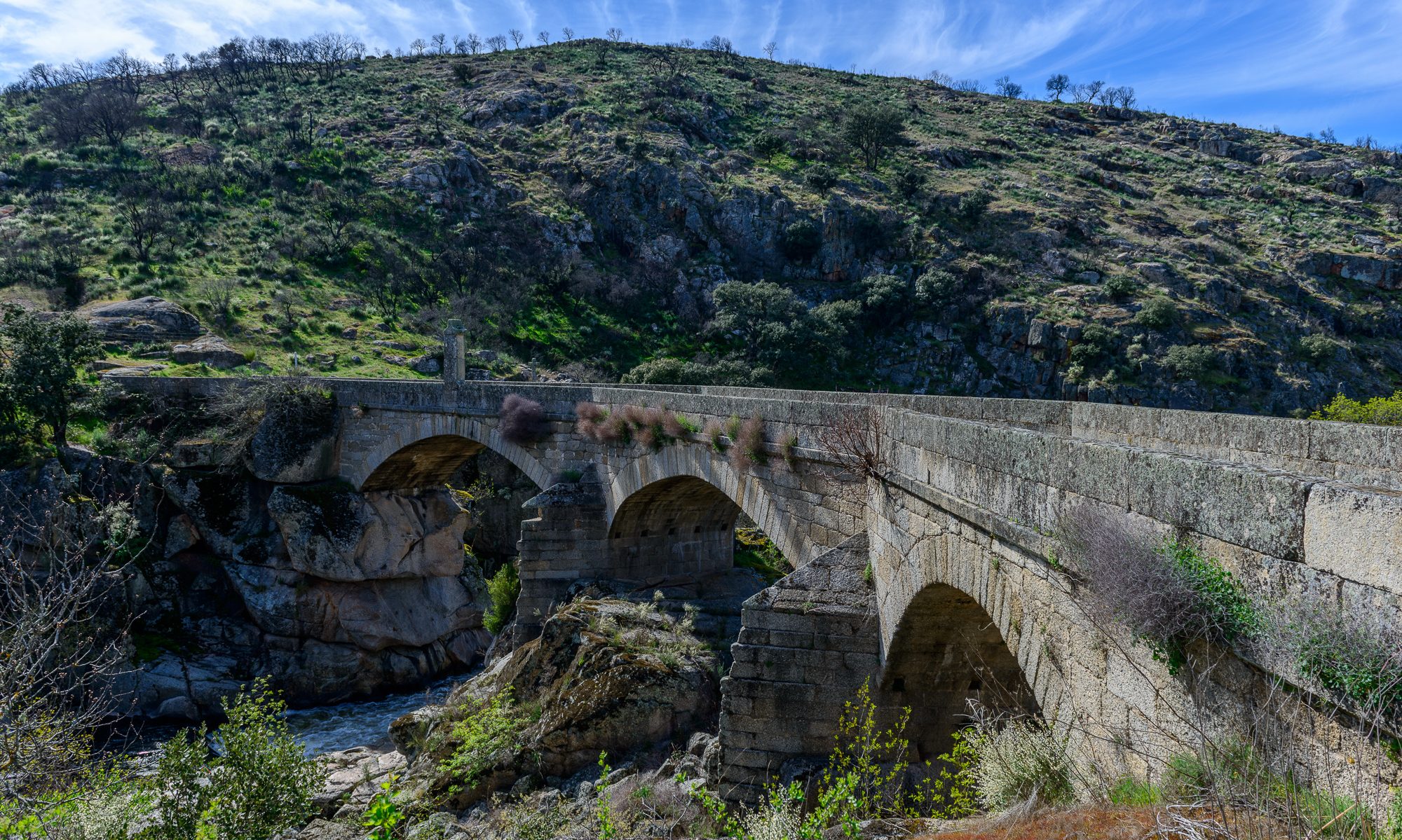
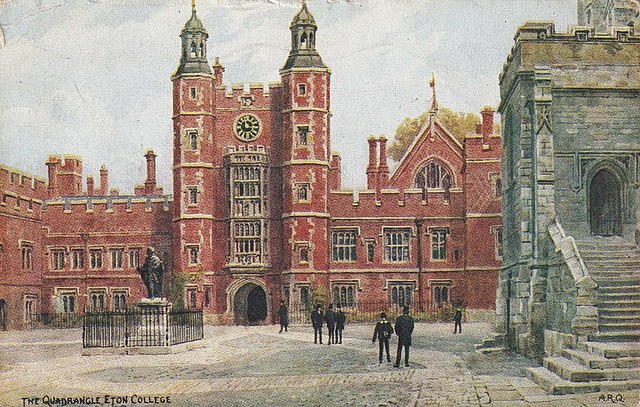
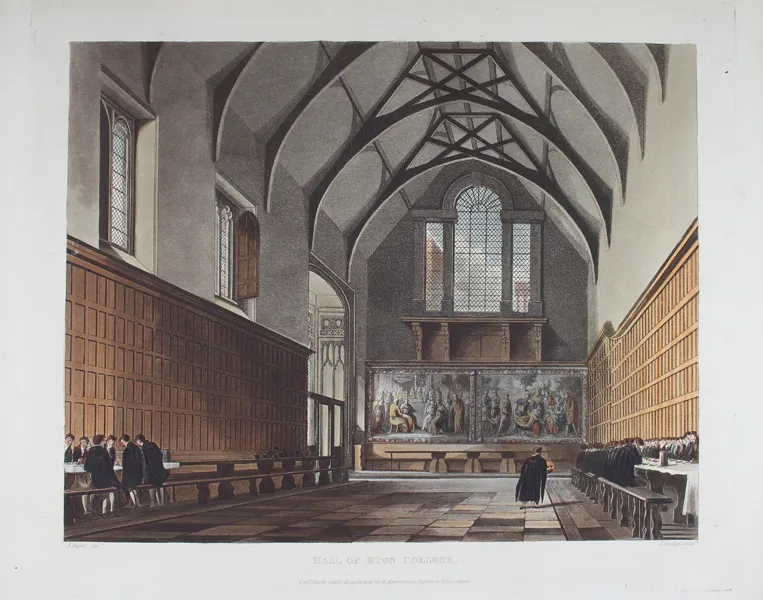

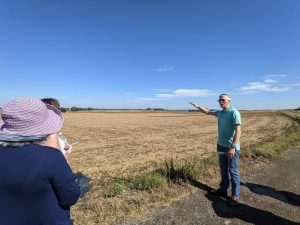
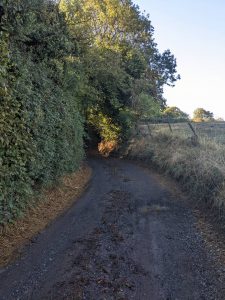 Number One London Tours
Number One London Tours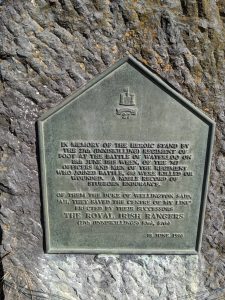 Features of the landscape like the covered way which is still partly visible, waist and head-high crops and surprisingly steep ridges help the story of the battle unfold far more easily than looking at maps. Gareth had maps a plenty though, to demonstrate each stage of the fighting as we reached it, starting from Papelotte and moving around the various parts of the field. He had also brought a copy of his fantastic
Features of the landscape like the covered way which is still partly visible, waist and head-high crops and surprisingly steep ridges help the story of the battle unfold far more easily than looking at maps. Gareth had maps a plenty though, to demonstrate each stage of the fighting as we reached it, starting from Papelotte and moving around the various parts of the field. He had also brought a copy of his fantastic Interspersed with clear, easy to understand descriptions of troop movements and the various attacks at different stages of the battle, were the individual stories from both Gareth and Kristine about the men who fought, suffered and died at Waterloo. I’ve seen many of these accounts before but hearing them read out on the ground where the action took place gave them a whole new meaning.
Interspersed with clear, easy to understand descriptions of troop movements and the various attacks at different stages of the battle, were the individual stories from both Gareth and Kristine about the men who fought, suffered and died at Waterloo. I’ve seen many of these accounts before but hearing them read out on the ground where the action took place gave them a whole new meaning. It was also horribly easy to imagine the aftermath, with dead and wounded strewn across the field. Injured men staggered towards anywhere they might find help and too many of them fell by the wayside. The memorials to the different armies and regiments as well as to a few individuals which are scattered around the battlefield highlight the poignant truth that most men who died at Waterloo had no marked grave, no memorial and quite possibly may not even have been buried at all.
It was also horribly easy to imagine the aftermath, with dead and wounded strewn across the field. Injured men staggered towards anywhere they might find help and too many of them fell by the wayside. The memorials to the different armies and regiments as well as to a few individuals which are scattered around the battlefield highlight the poignant truth that most men who died at Waterloo had no marked grave, no memorial and quite possibly may not even have been buried at all.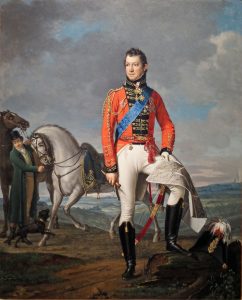
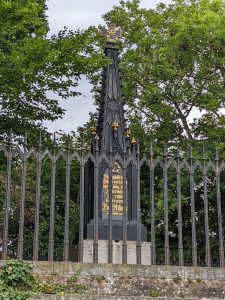
 When we emerged, it was dark. Kristine had bought some flowers and a few of us walked up towards the Lion’s Mound which is lit up at night. It looked spectacular and despite all the jokes about it spoiling the battlefield, it felt like a fitting memorial that night, not to the Prince of Orange or Wellington or to any of the other individual commanders but to the thousands of anonymous men and animals who died on that field two hundred and seven years ago.
When we emerged, it was dark. Kristine had bought some flowers and a few of us walked up towards the Lion’s Mound which is lit up at night. It looked spectacular and despite all the jokes about it spoiling the battlefield, it felt like a fitting memorial that night, not to the Prince of Orange or Wellington or to any of the other individual commanders but to the thousands of anonymous men and animals who died on that field two hundred and seven years ago.  We placed the flowers on the edge of the field, not on any particular monument but just on a spot where any man might have fallen and stood quietly, listening on a phone to John Tams singing Spanish Ladies, a haunting folk song. A version of that song existed in 1815 and might have been sung by the campfires by men who did not survive that day. It seemed an appropriate memorial to the ordinary soldiers and the perfect way to end Waterloo 2022: the Battlefield Tour.
We placed the flowers on the edge of the field, not on any particular monument but just on a spot where any man might have fallen and stood quietly, listening on a phone to John Tams singing Spanish Ladies, a haunting folk song. A version of that song existed in 1815 and might have been sung by the campfires by men who did not survive that day. It seemed an appropriate memorial to the ordinary soldiers and the perfect way to end Waterloo 2022: the Battlefield Tour.
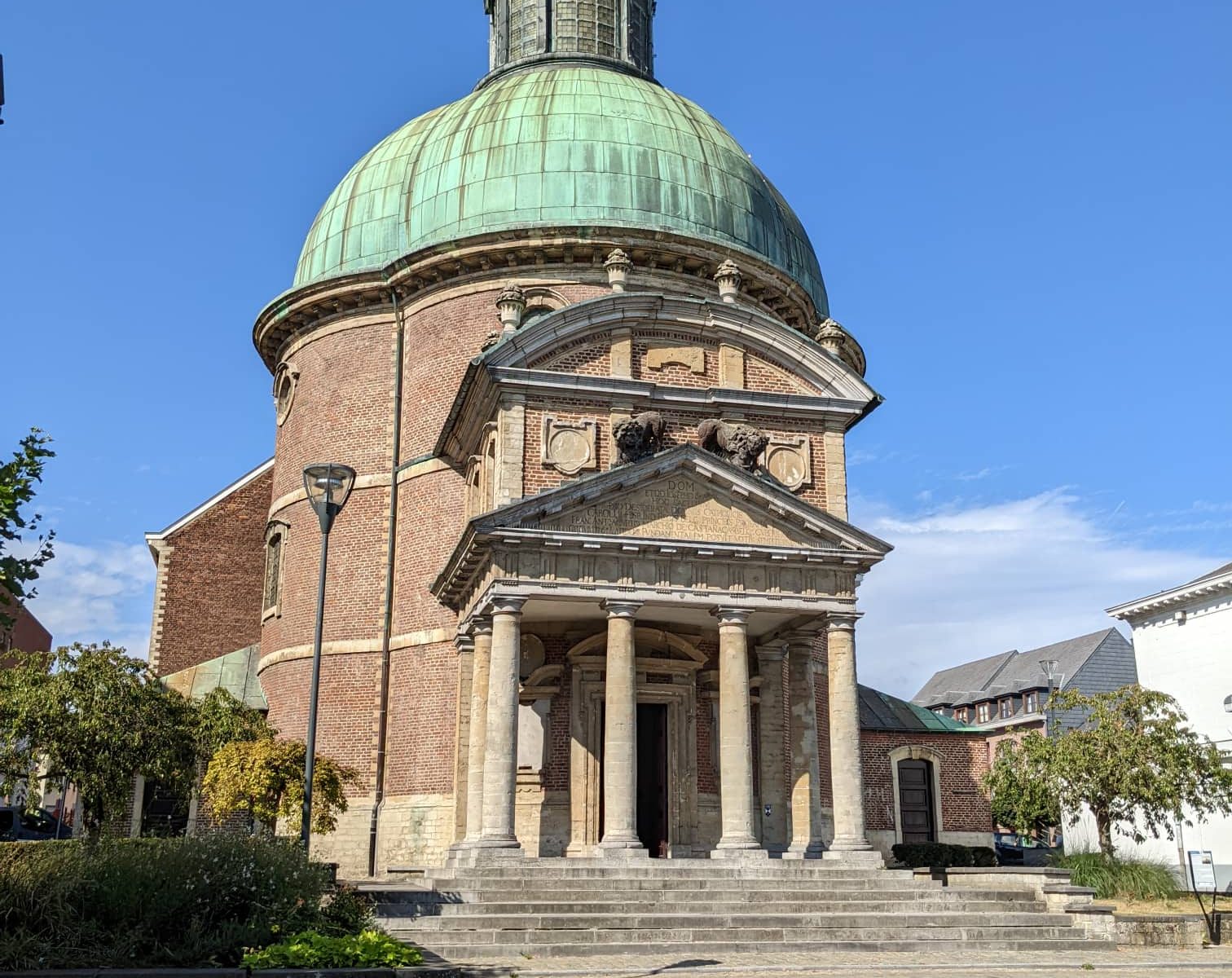
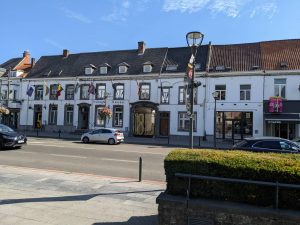
 I have no idea whether there’s something political about this, whether it’s considered Napoleon was the most important person at Waterloo given that he was an Emperor or whether they just don’t think Wellington or Blucher memorabilia will sell. I do think it should probably be redressed, but if it’s a marketing decision then I guess that’s a good enough reason. All the same, Napoleon as a dog was a bit much for me.
I have no idea whether there’s something political about this, whether it’s considered Napoleon was the most important person at Waterloo given that he was an Emperor or whether they just don’t think Wellington or Blucher memorabilia will sell. I do think it should probably be redressed, but if it’s a marketing decision then I guess that’s a good enough reason. All the same, Napoleon as a dog was a bit much for me.
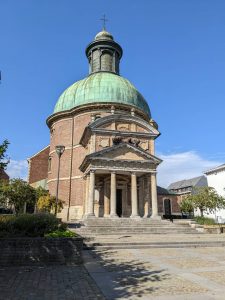 Across the busy road from the Wellington Museum is the elaborate church which was there at the time of the battle and used, like many churches, as a hospital to receive wounded men. Those of you who have followed me for a while know that I have a thing about old churches and this one was particularly peaceful, with a number of memorials to the men who fought and died during the Waterloo campaign. Memorials at this time tended to be paid for either by the family of the dead man or by subscription through the various battalions and regiments, so not surprisingly more of them relate to the wealthier regiments. Very few of the memorials even mention the NCOs and enlisted men apart from this one in the church, which may well be the first of its kind.
Across the busy road from the Wellington Museum is the elaborate church which was there at the time of the battle and used, like many churches, as a hospital to receive wounded men. Those of you who have followed me for a while know that I have a thing about old churches and this one was particularly peaceful, with a number of memorials to the men who fought and died during the Waterloo campaign. Memorials at this time tended to be paid for either by the family of the dead man or by subscription through the various battalions and regiments, so not surprisingly more of them relate to the wealthier regiments. Very few of the memorials even mention the NCOs and enlisted men apart from this one in the church, which may well be the first of its kind.
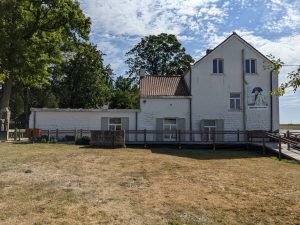 After lunch we moved on to Napoleon’s Headquarters in the farmhouse of Le Caillou, where Napoleon and his staff spent the night of June 17, 1815. The museum collection is spread over five rooms and tells the story of the Emperor’s actions in the hours before Waterloo. There are a number of artefacts relating to Napoleon, though Gareth queried whether some of the furniture was authentic given that the Prussians reputedly set fire to everything on their way through after Napoleon’s departure. Still, it gives a good sense of how the farm might have looked at the time.
After lunch we moved on to Napoleon’s Headquarters in the farmhouse of Le Caillou, where Napoleon and his staff spent the night of June 17, 1815. The museum collection is spread over five rooms and tells the story of the Emperor’s actions in the hours before Waterloo. There are a number of artefacts relating to Napoleon, though Gareth queried whether some of the furniture was authentic given that the Prussians reputedly set fire to everything on their way through after Napoleon’s departure. Still, it gives a good sense of how the farm might have looked at the time. In the garden outside the farmhouse are one or two memorials. There is also an ossuary, which is a small building intended to serve as the final resting place of human bones. Ossuaries are often used where burial space is scarce but in this case it has become a depository for bones found on the battlefield over the years. I’ve seen photos of this but found the real thing unexpectedly moving.
In the garden outside the farmhouse are one or two memorials. There is also an ossuary, which is a small building intended to serve as the final resting place of human bones. Ossuaries are often used where burial space is scarce but in this case it has become a depository for bones found on the battlefield over the years. I’ve seen photos of this but found the real thing unexpectedly moving.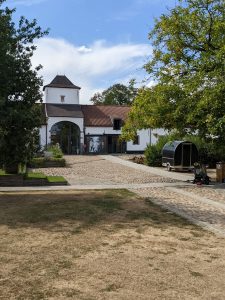
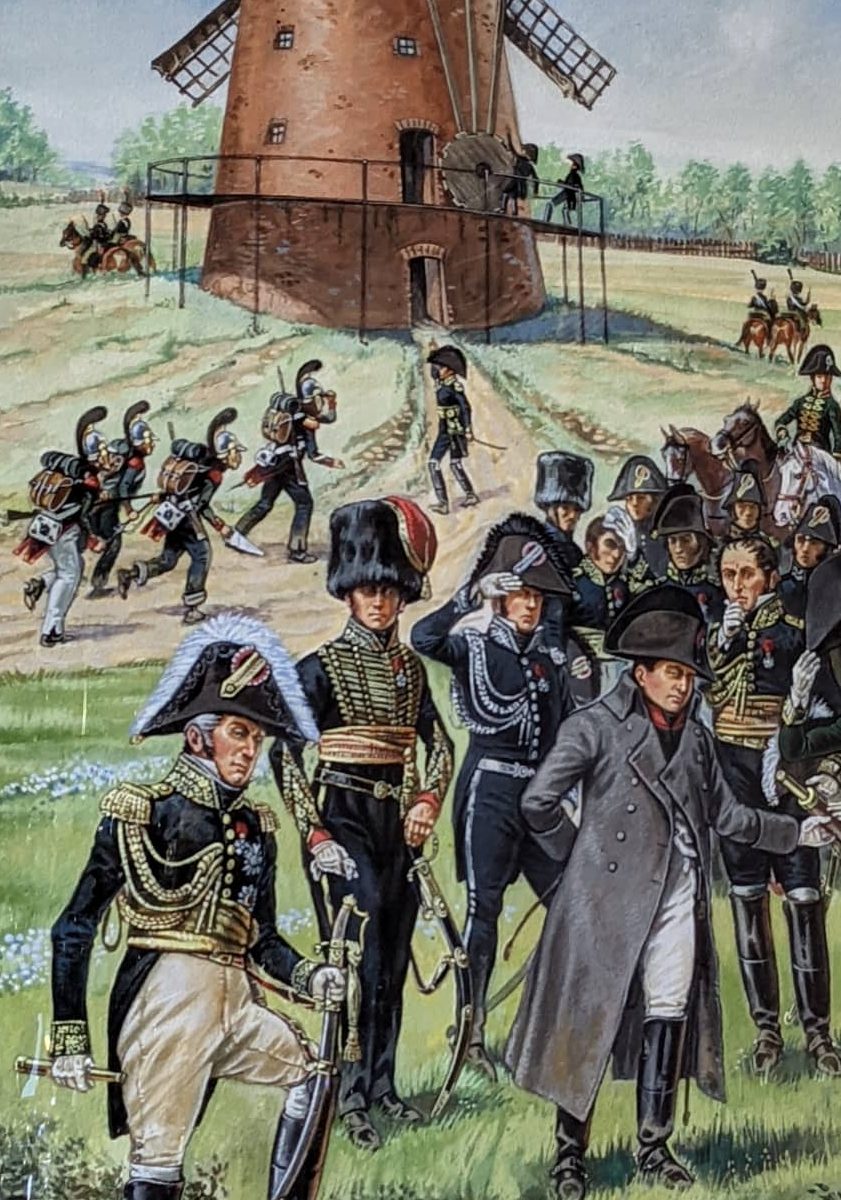



 Our next visit was to the small but very good museum in Ligny. It covers both Ligny and Quatre Bras and gave a very good sense of what happened on 16th June in these small villages and towns as the French inflicted a bloody defeat on Blucher’s Prussians and fought to a stalemate against Wellington’s Allied army. I was shocked at the extent of the casualties at both battles. Somehow I’d always had the vague impression that these were just skirmishes ahead of the main battle, but they clearly weren’t. All three armies were weakened by what happened on this day and it must have had an effect on what happened at Waterloo.
Our next visit was to the small but very good museum in Ligny. It covers both Ligny and Quatre Bras and gave a very good sense of what happened on 16th June in these small villages and towns as the French inflicted a bloody defeat on Blucher’s Prussians and fought to a stalemate against Wellington’s Allied army. I was shocked at the extent of the casualties at both battles. Somehow I’d always had the vague impression that these were just skirmishes ahead of the main battle, but they clearly weren’t. All three armies were weakened by what happened on this day and it must have had an effect on what happened at Waterloo.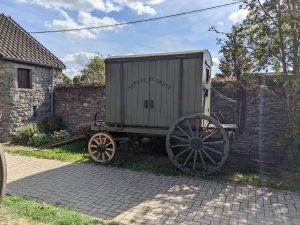

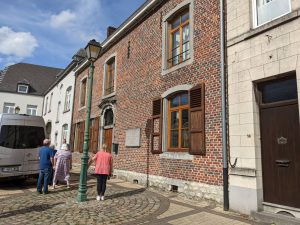
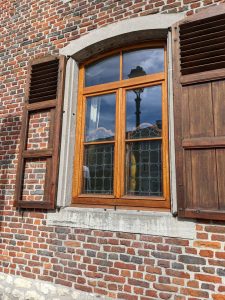

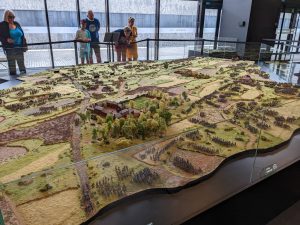 Waterloo 2022 – the Waterloo Museum and Hougoumont and we don’t hang about on the
Waterloo 2022 – the Waterloo Museum and Hougoumont and we don’t hang about on the 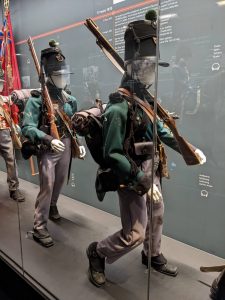 The museum gives an excellent overview of the history of the French revolution, Napoleon’s rise to power and the various coalitions and wars which led inexorably towards the Waterloo campaign. There are fabulous displays of weapons and uniforms from troops on both sides of the campaign, maps and models depicting the events of 1815 and the famous Waterloo Panorama which was painted in 1912 by Louis Dumoulin, and occupies a circular building. It is 110 metres in circumference and 12 metres high and the soundtrack plunges you into the midst of the battle. Despite, as Gareth assured us, a number of inaccuracies, it’s genuinely impressive and I’m glad we managed to see it before it closes for restoration later this month.
The museum gives an excellent overview of the history of the French revolution, Napoleon’s rise to power and the various coalitions and wars which led inexorably towards the Waterloo campaign. There are fabulous displays of weapons and uniforms from troops on both sides of the campaign, maps and models depicting the events of 1815 and the famous Waterloo Panorama which was painted in 1912 by Louis Dumoulin, and occupies a circular building. It is 110 metres in circumference and 12 metres high and the soundtrack plunges you into the midst of the battle. Despite, as Gareth assured us, a number of inaccuracies, it’s genuinely impressive and I’m glad we managed to see it before it closes for restoration later this month.

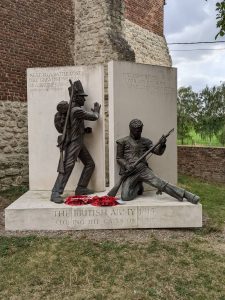

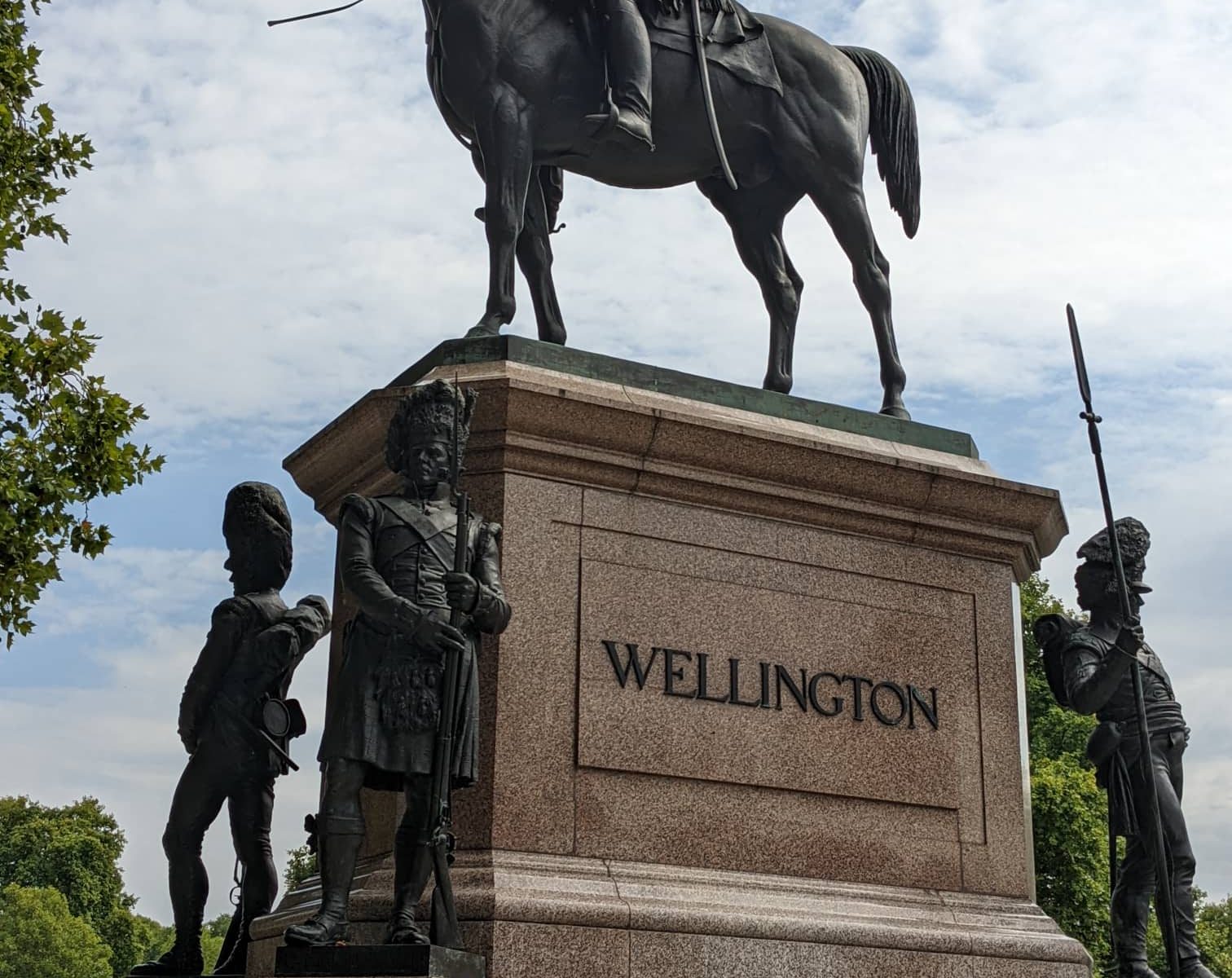
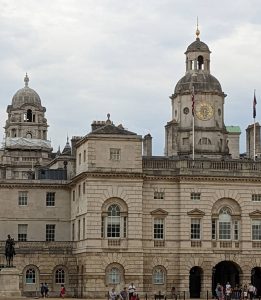

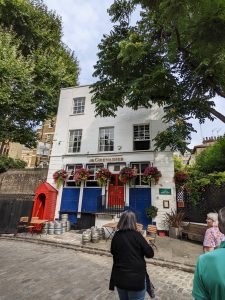
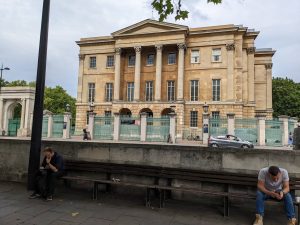
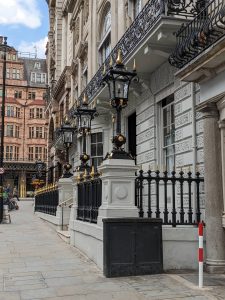

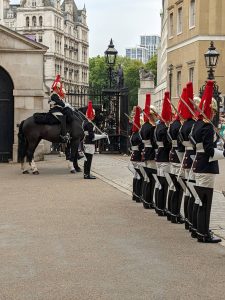 Our final stop for the day was the Horse Guards museum and were in time to see an inspection parade. After that it was back to the hotel in preparation for an early start on the Eurostar to Brussels the following morning.
Our final stop for the day was the Horse Guards museum and were in time to see an inspection parade. After that it was back to the hotel in preparation for an early start on the Eurostar to Brussels the following morning.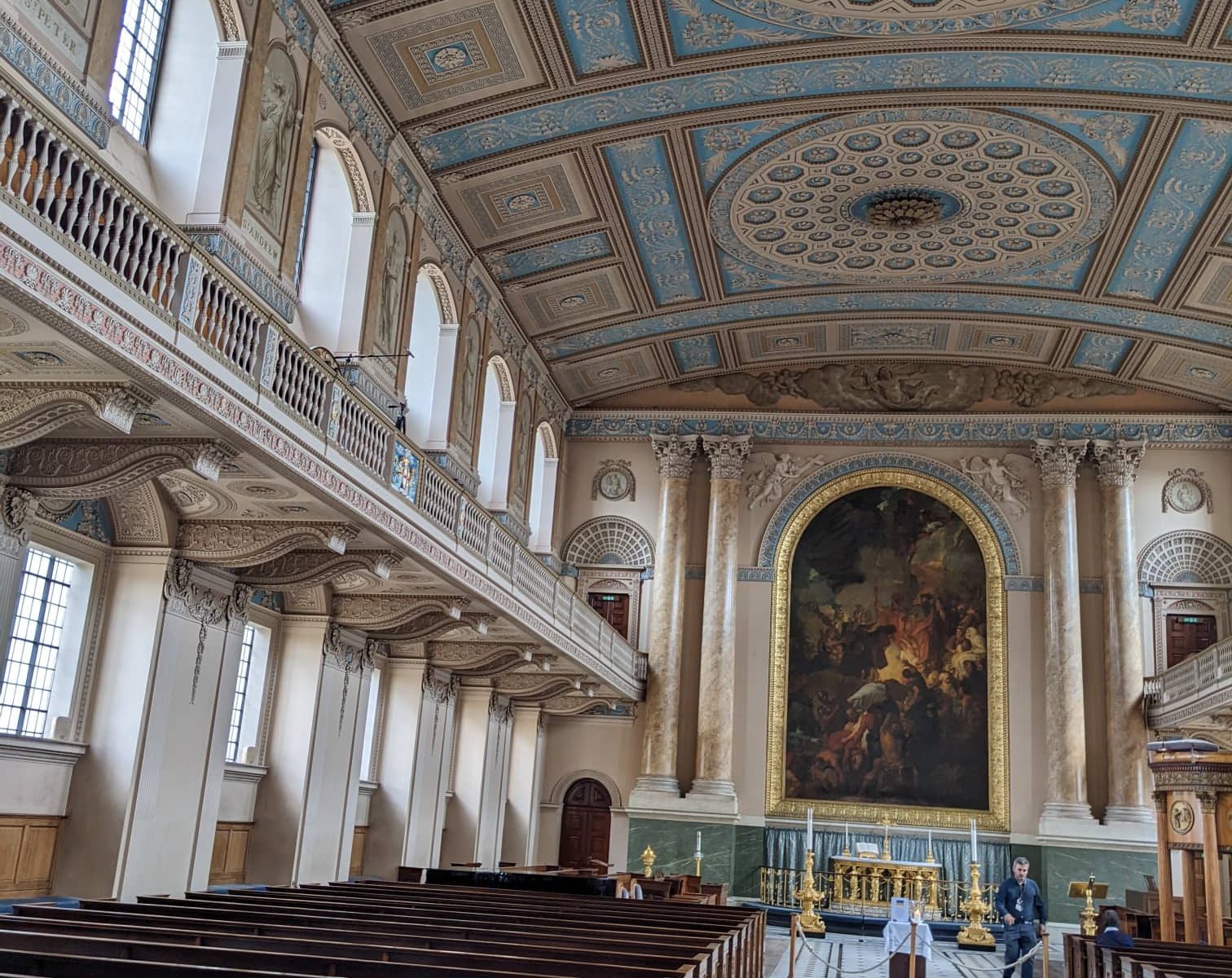
 Waterloo 2022: prelude only really came about because I live on the Isle of Man. My much anticipated
Waterloo 2022: prelude only really came about because I live on the Isle of Man. My much anticipated 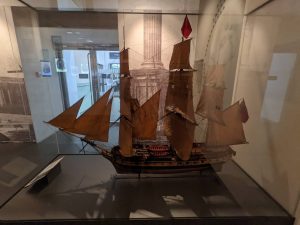 The
The 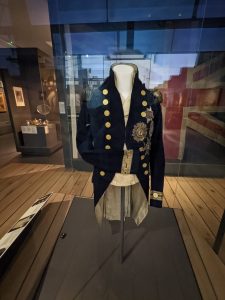 There is, as usual, an abundance of information and artefacts about Lord Nelson, England’s most feted naval hero including the clothing he was wearing when he was shot down on the deck of the Victory during the Battle of Trafalgar. While I’m grateful that the national obsession with Nelson means that EVERY navy museum has something relating to my period of interest, I can’t help imagining the howls of indignation of a few other navy officers of the era who really did some quite impressive stuff themselves, but don’t get a mention. Nevertheless, the National Maritime Museum is fascinating, with loads to see and do for both adults and children and I highly recommend it.
There is, as usual, an abundance of information and artefacts about Lord Nelson, England’s most feted naval hero including the clothing he was wearing when he was shot down on the deck of the Victory during the Battle of Trafalgar. While I’m grateful that the national obsession with Nelson means that EVERY navy museum has something relating to my period of interest, I can’t help imagining the howls of indignation of a few other navy officers of the era who really did some quite impressive stuff themselves, but don’t get a mention. Nevertheless, the National Maritime Museum is fascinating, with loads to see and do for both adults and children and I highly recommend it.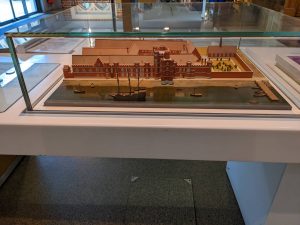
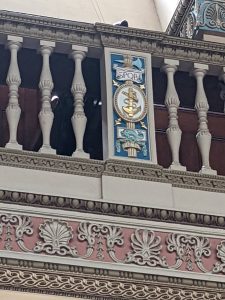 Greenwich Seaman’s Hospital was built on the orders of Mary II who was affected by the sight of wounded sailors coming home from the Battle of La Hogue. It is incredibly beautiful architecturally and both the Chapel and the Painted Hall are well worth a visit. I particularly liked the Chapel, which has naval motifs incorporated into the design.
Greenwich Seaman’s Hospital was built on the orders of Mary II who was affected by the sight of wounded sailors coming home from the Battle of La Hogue. It is incredibly beautiful architecturally and both the Chapel and the Painted Hall are well worth a visit. I particularly liked the Chapel, which has naval motifs incorporated into the design. 

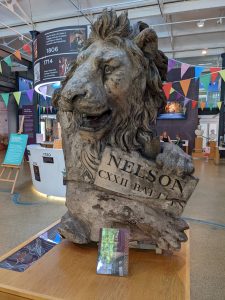 Nelson also features a fair bit, surprisingly enough. England’s Hero lay in state for several days in the Painted Hall and there is a small dedicated Nelson Room, but my favourite artefact is a lion which was apparently a model piece for the Nelson frieze. The lion is holding a stone which purports to claim that Nelson fought in 122 battles. I had this piece of information from the guide and I’ve not managed to check it at all, but my extensive reading on the subject of the Napoleonic navy so far has suggested that most of the time was spent either on tedious blockade duty or seething at home on half-pay. Nobody seemed able to answer my question about how Nelson managed to see quite so much action during his time in the navy but if I get to the bottom of it, I’ll let you know. Alternatively, if anybody else knows where I can find a list of these battles, I’d love to hear it. Nice lion, though.
Nelson also features a fair bit, surprisingly enough. England’s Hero lay in state for several days in the Painted Hall and there is a small dedicated Nelson Room, but my favourite artefact is a lion which was apparently a model piece for the Nelson frieze. The lion is holding a stone which purports to claim that Nelson fought in 122 battles. I had this piece of information from the guide and I’ve not managed to check it at all, but my extensive reading on the subject of the Napoleonic navy so far has suggested that most of the time was spent either on tedious blockade duty or seething at home on half-pay. Nobody seemed able to answer my question about how Nelson managed to see quite so much action during his time in the navy but if I get to the bottom of it, I’ll let you know. Alternatively, if anybody else knows where I can find a list of these battles, I’d love to hear it. Nice lion, though.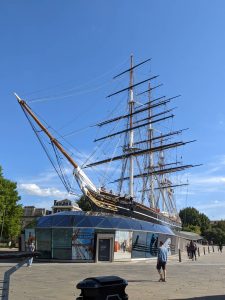 My final visit of the day was to the Cutty Sark, a nineteenth century tea clipper located in dry dock on the river bank. The Cutty Sark has a very sentimental place in my heart as it was a favourite place to visit as a child. We used to go to Greenwich a lot, getting the bus from Mile End and then walking through the Victorian foot tunnel under the river. I loved it there, the park and the eclectic market, the little shops, the Queen’s House and the Observatory, the graceful buildings of the Naval College. That much history in one place always set off my very eccentric imagination about the men and women who had lived in these buildings and walked these streets in the past. But the absolute joy for me was the once or twice a year when we were allowed to actually go aboard the Cutty Sark.
My final visit of the day was to the Cutty Sark, a nineteenth century tea clipper located in dry dock on the river bank. The Cutty Sark has a very sentimental place in my heart as it was a favourite place to visit as a child. We used to go to Greenwich a lot, getting the bus from Mile End and then walking through the Victorian foot tunnel under the river. I loved it there, the park and the eclectic market, the little shops, the Queen’s House and the Observatory, the graceful buildings of the Naval College. That much history in one place always set off my very eccentric imagination about the men and women who had lived in these buildings and walked these streets in the past. But the absolute joy for me was the once or twice a year when we were allowed to actually go aboard the Cutty Sark.

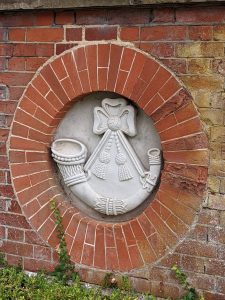 Lynn’s Grand Tour Summer 2022 sounds a lot grander than it really was. I was not in fact meandering through Europe with a fawning retinue and a sketch book, I was simply travelling around England to visit friends and family. Nevertheless, I was away from my island home for more than two weeks, WITHOUT MY DOGS which made it an event worthy of a blog post.
Lynn’s Grand Tour Summer 2022 sounds a lot grander than it really was. I was not in fact meandering through Europe with a fawning retinue and a sketch book, I was simply travelling around England to visit friends and family. Nevertheless, I was away from my island home for more than two weeks, WITHOUT MY DOGS which made it an event worthy of a blog post.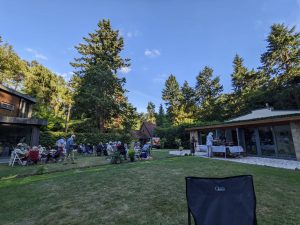 We started off with family, at an outdoor party for my brother-in-law’s 70th birthday. This was an outdoor event and the weather was perfect. Curry and music, dancing on the lawn and then a spectacular firework display to finish was a great start to our trip.
We started off with family, at an outdoor party for my brother-in-law’s 70th birthday. This was an outdoor event and the weather was perfect. Curry and music, dancing on the lawn and then a spectacular firework display to finish was a great start to our trip.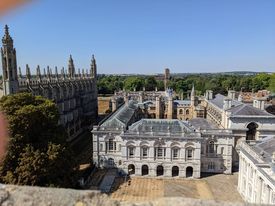 We spent a few days in Nottinghamshire before moving on to Cambridge to stay with my friend Jacqui. The weather, if anything, was too warm but it didn’t stop us from doing a tour of Cambridge. I’ve not been there for many years and it was fabulous to have a tour guide who genuinely loves the city. We went from King’s College to climb the tower of Great St Mary’s which has lovely views over the city.
We spent a few days in Nottinghamshire before moving on to Cambridge to stay with my friend Jacqui. The weather, if anything, was too warm but it didn’t stop us from doing a tour of Cambridge. I’ve not been there for many years and it was fabulous to have a tour guide who genuinely loves the city. We went from King’s College to climb the tower of Great St Mary’s which has lovely views over the city. This was followed by lunch at
This was followed by lunch at 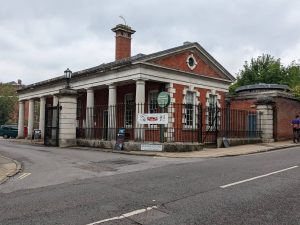 From Cambridge, we moved on to Winchester to visit some old friends who live just outside the city. I love Winchester and it isn’t entirely because of the
From Cambridge, we moved on to Winchester to visit some old friends who live just outside the city. I love Winchester and it isn’t entirely because of the 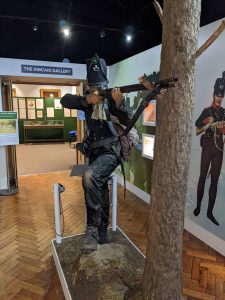
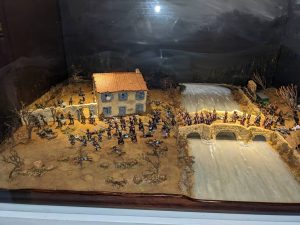
 Winchester is also fairly close to one of my other favourite museums and I was lucky enough to get another fabulously sunny day for a trip to the
Winchester is also fairly close to one of my other favourite museums and I was lucky enough to get another fabulously sunny day for a trip to the 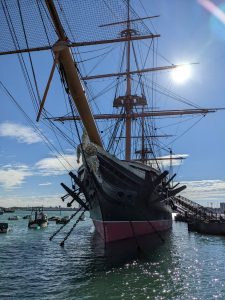
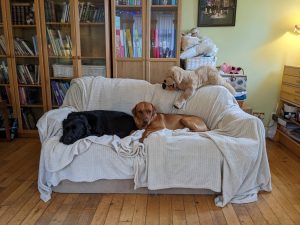 After a visit to London to see my mother-in-law we were finally on our way home. It felt like a very long time since we set off. The dogs went insane when we got home. I’m sure you’ve all seen the online videos of servicemen who have been away for five years being jumped on by their dogs on their return. These don’t impress me, I can get the same result by going to the supermarket. All the same, Oscar and Alfie are delighted I’m back and relieved to be able to settle into their routine again. I daren’t tell them I’m off to Waterloo in just over a week…
After a visit to London to see my mother-in-law we were finally on our way home. It felt like a very long time since we set off. The dogs went insane when we got home. I’m sure you’ve all seen the online videos of servicemen who have been away for five years being jumped on by their dogs on their return. These don’t impress me, I can get the same result by going to the supermarket. All the same, Oscar and Alfie are delighted I’m back and relieved to be able to settle into their routine again. I daren’t tell them I’m off to Waterloo in just over a week…
 Tangled Spirits by Kate Shanahan
Tangled Spirits by Kate Shanahan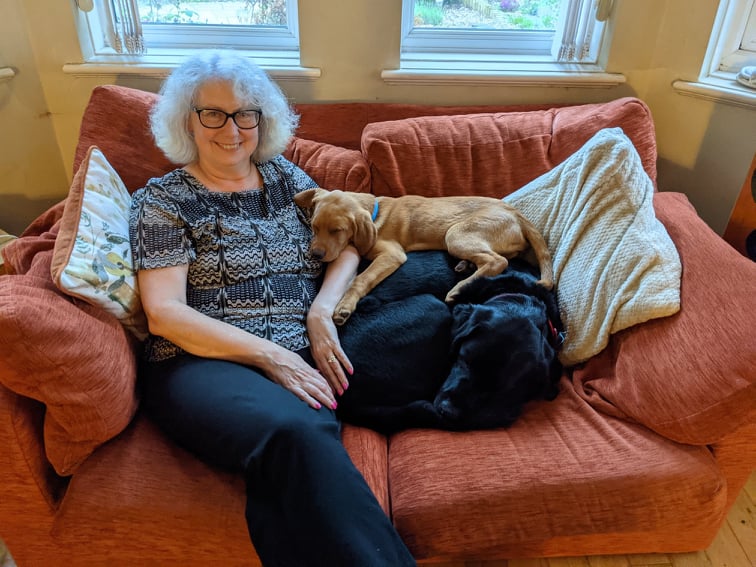
 Being sixty is an unusual post for me, as it’s not about any of the topics I blog about. People come to Writing with Labradors for my
Being sixty is an unusual post for me, as it’s not about any of the topics I blog about. People come to Writing with Labradors for my 
 I think attitudes towards age and growing older are very individual. Having three young people in their early twenties living in the same house means I have no chance to become set in my ways. I listen to their music, watch their TV shows and discuss their political views on a daily basis and it wouldn’t occur to me to see that as a bad thing. I’ve had a long and enjoyable life so far but I realise that I still look forward rather than back. I don’t hark back to the good old days. I think change and new ideas and different attitudes are all good for me.
I think attitudes towards age and growing older are very individual. Having three young people in their early twenties living in the same house means I have no chance to become set in my ways. I listen to their music, watch their TV shows and discuss their political views on a daily basis and it wouldn’t occur to me to see that as a bad thing. I’ve had a long and enjoyable life so far but I realise that I still look forward rather than back. I don’t hark back to the good old days. I think change and new ideas and different attitudes are all good for me.
 So what have I done with my 59th year? Well, it’s been an improvement on the previous one in many ways. I managed to get through the Covid lockdowns without getting arrested, which was genuinely a relief. I published three short stories and finally completed book seven of the Peninsular War Saga, which felt like a real achievement after the problems of the previous years. I’ve made a solid start on the third Manxman book and fallen in love with my naval characters all over again.
So what have I done with my 59th year? Well, it’s been an improvement on the previous one in many ways. I managed to get through the Covid lockdowns without getting arrested, which was genuinely a relief. I published three short stories and finally completed book seven of the Peninsular War Saga, which felt like a real achievement after the problems of the previous years. I’ve made a solid start on the third Manxman book and fallen in love with my naval characters all over again. I got a new puppy, a new baby brother for Oscar. No dog could ever replace Toby and Joey in my heart, but Alfie, my little Chaos Demon has found his own place there.
I got a new puppy, a new baby brother for Oscar. No dog could ever replace Toby and Joey in my heart, but Alfie, my little Chaos Demon has found his own place there.  I’ve made contact with one or two old friends and made a promise to do more of this in the year to come. I took myself off on my very own writer’s retreat and enjoyed it so much, I intend to do it again in the coming year.
I’ve made contact with one or two old friends and made a promise to do more of this in the year to come. I took myself off on my very own writer’s retreat and enjoyed it so much, I intend to do it again in the coming year.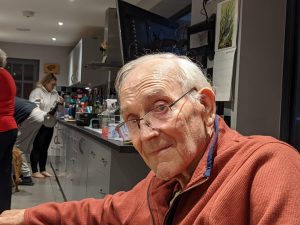 I lost my father-in-law, whom I loved, and organised his funeral. I learned things about families and how difficult it is to get it right. I also learned that sometimes there’s nothing you can do to help and you just have to let go.
I lost my father-in-law, whom I loved, and organised his funeral. I learned things about families and how difficult it is to get it right. I also learned that sometimes there’s nothing you can do to help and you just have to let go.